Endangered Pollinators
Numerous pollinator species are at risk and listed as federally endangered or threatened including: 1 fly, 3 bats, 5 birds, 8 bees, and 24 butterflies and moths. Disturbances such as habitat loss, climate change, and application of agricultural pesticides contribute greatly to diminishing populations and disrupt ecological interactions. The problem of extinction can lead to a crippling disaster for ecological resilience and economic interests.
Order NowLearn all about the plants and pollinators below.
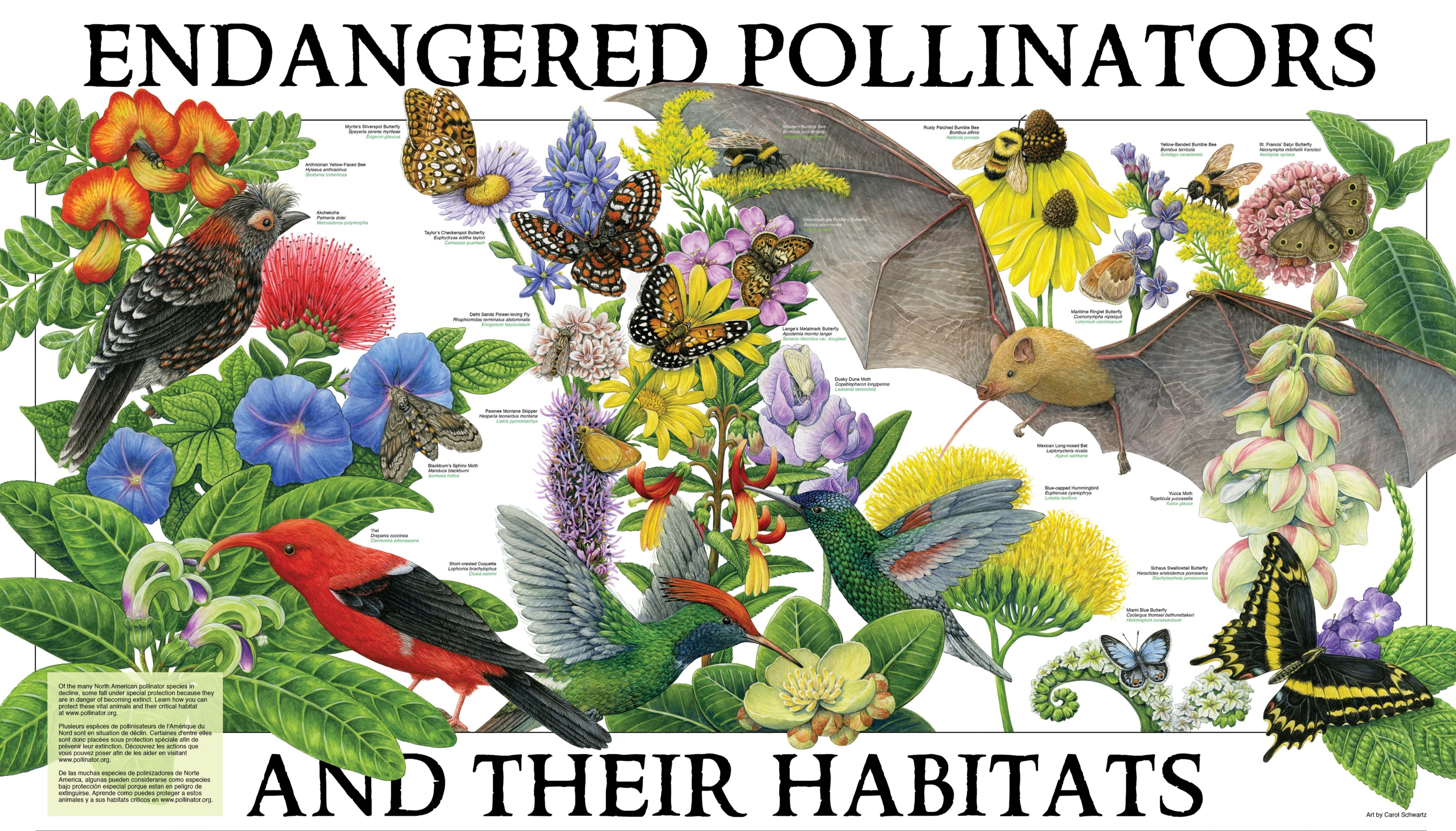
Endangered Pollinators
In 1973, the United States Congress passed the Endangered Species Act (ESA; 16 U.S.C. § 1531 et seq.) with the intention of protecting vulnerable species and preserving the ecosystems that we all share. There are numerous species that are at risk and listed as federally endangered or threatened including: 1 fly, 3 bats, 5 birds, 8 bees, and 24 butterflies and moths. Disturbances such as habitat loss, climate change, and application of agricultural pesticides contribute greatly to diminishing populations and disrupt ecological interactions. The problem of extinction can lead to a crippling disaster for ecological resilience and economic interests.
Pollinators play a critical role in our global food system; at least 80% of crops we consume are pollinated by bees and other wildlife. The relationship between pollinators and their plants are intrinsically linked, the decline of pollinators make plants more vulnerable to secondary extinction. Conversely, the populations of pollinators determine the stability of plants and our ecosystem health. As keystone species, pollinators have substantial impact on our global systems. Recognizing the importance of vulnerable pollinator species and their habitats, as well as initiating preservation efforts before there is a need to list them as endangered or threatened, is key to maintaining our biological balance.
This information is of great value to foresee consequences of pollinator losses and to identify target species for effective conservation. Endeavors such as the Monarch Wings Across America and Bee Friendly Farming techniques can aid in the conservation of critical habitat by prioritizing pollinators and reinforcing the importance of such species. By placing emphasis on the natural networks at play between plants, pollinators, and people, we can begin to ensure healthy ecosystems and food security for all.
National Center for Biotechnology Information: Plant survival and keystone pollinator species in stochastic coextinction models: role of intrinsic dependence on animal-pollination
The Plants
Sesbania tomentosa ('Ohai)
An erect to prostrate shrub, sometimes growing to the size of a small tree. Branches can be up to 14 meters long when prostrate. The plant has salmon colored flowers tinged with yellow, orange red, and scarlet. It is a Federally Listed Endangered Species, and actions are being taken both to protect current populations and establish new populations.
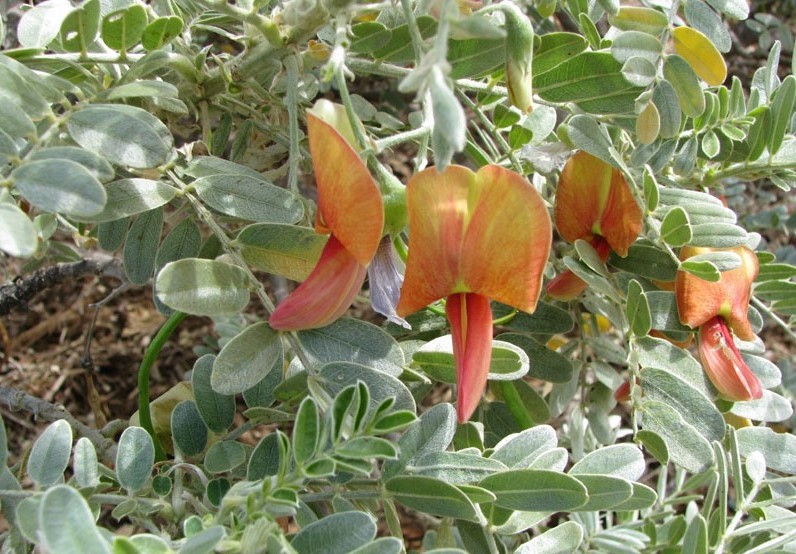
Geographic Distribution: Endemic to all of the main islands of Hawai’i. Current populations exist on O’ahu, Moloka’i, Maui, Kaua’i, Kaho’olawe, Hawai’i, Nihoa and Necker.
Habitat: Dry shrublands or (rarely) dry forests. Found on calcareous beaches and sand dunes, rocky ridges and slopes, deep red soil, and soil pockets on lava.
Pollinators: Bees, including Yellow-Faced Bee (Hylaeus anthracinus).
Height: 2.5 - 6 m
Bloom Period: Winter and spring.
Species Facts: Before this plant was added to the endangered species list, many Hawaiians used the flowers for making lei. In the Hawaiian tradition, a lei is a garland used as a symbol of affection and to officially establish peace between two groups. Today it is illegal to possess such flowers in a garden setting and you very rarely, if ever, see a lei made of ‘Ohai flowers.
Native Plants Hawaii: Sesbania tomentosa
Hawai'i Department of Land and Natural Resources: Sesbania tomentosa
Metrosideros polymorpha ('Ohi'a lehua)
A slow-growing native hardwood tree. It is the first tree to appear on new lava flows where it offers watershed protection, and it often starts as an epiphyte in fern forests. The wood is of fine texture and is often used for flooring, fence posts and fuel. This tree is the most abundant tree in Hawai’i and provides important habitat to native birds, several of which are endangered.
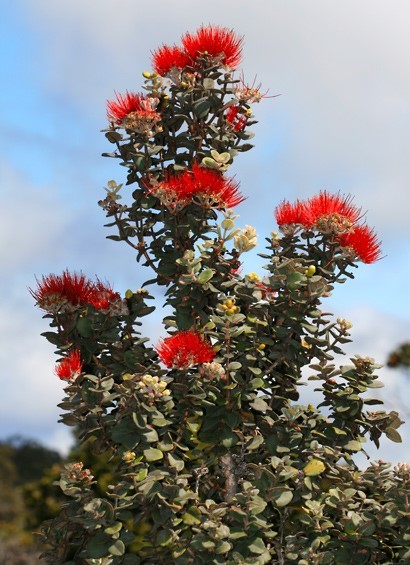
Geographic Distribution: Endemic to and present on O’ahu, Moloka’i, Maui, Kaua’i, Lana’i, and Hawai’i.
Habitat: Grows just above sea level to 2,600 meters, generally in areas with rainfall of more than 50 cm. The maximum stand growth of M. polymorpha exists on young volcanic substrates in rainforest habitats on Hawai’i.
Pollinators: Birds, such as the Akohekohe or Crested Honeycreeper (Palmeria dolei), and insects are the most important pollinators.
Mature Height: 20 m
Bloom Period: Flowering generally peaks in spring or summer, but some varieties peak in fall or winter.
Species Facts: The species name polymorpha, meaning "many forms," is most apropos. Probably no other native Hawaiian plant is found in a greater number of varieties than this one. The sheer number and variations of ʻōhiʻa shrub and tree forms, leaf colors and shapes, and floral colors is baffling.
Wildlife of Hawaii: Metrosideros polymorpha – 'Ohi'a Lehua
Native Plants Hawaii: Metrosideros polymorpha
Ipomoea indica (blue morning glory)
A flowering, branched vine with a herbaceous base and twining stems. The vine produces flowers that are 5 - 7 cm long and blue or purple in color. It is considered invasive in many locations including Australia and California, where its trailing stems allow it to crowd native vegetation by smothering shrubs and trees.
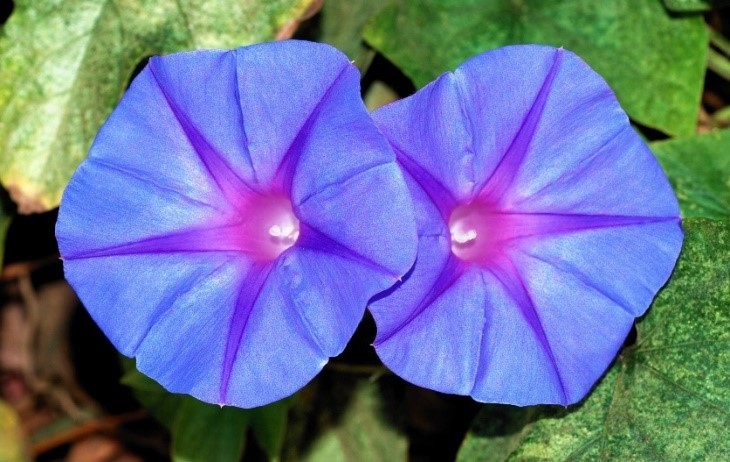
Geographic Distribution: The coastal districts of eastern Australia, southern Europe, southern New Zealand, southern USA, Puerto Rico, eastern and southern Africa, and native to all of the main Hawai’ian islands.
Habitat: Grows along forest edges, freshwater wetlands, woodlands and riparian habitats. In Hawai’i, it is common in dry, disturbed areas at low elevation (less than 153 m).
Pollinators: Long-tongued bees and moths, including Blackburn's Sphinx Moth (Manduca Blackburn).
Mature Height: Vines can be more than 4.5 m long with heart shaped leaves.
Bloom Period: Summer and spring.
Species Facts: When dogs ingest the seeds of this flowering plant, morning glory poisoning in occurs. Lysergic alkaloids contained within the morning glory seeds and are toxic to dogs and cause severe distress.
Wag.com: Morning Glory Poisoning in Dogs
Clermontia arborescens (Oha wai nui)
Branching, woody shrubs or small trees. Species can be either terrestrials or epiphytes, where they grow on other plants. The plants produce two or more showy, greenish-white flowers with a magenta interior. Yellow or orange berries are often produced after flowering, which early Hawai’ians used as a minor food source.
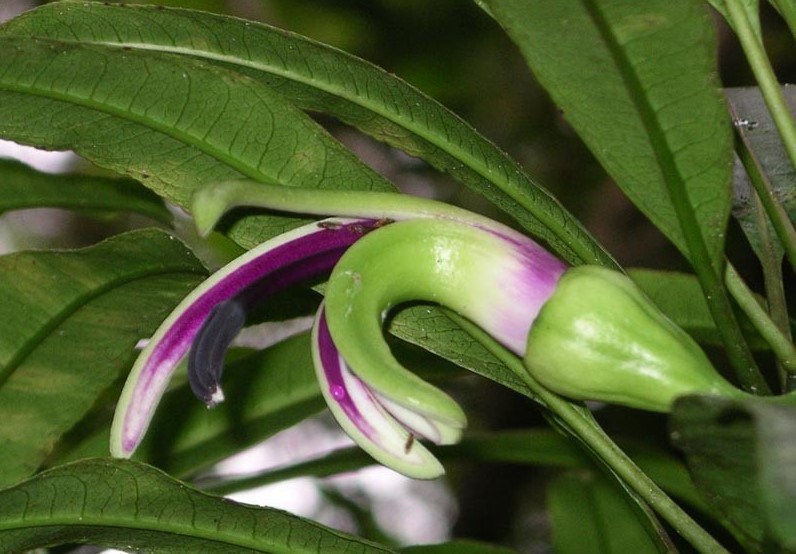
Geographic Distribution: Native to Moloka’i, Lana’i, and Maui.
Habitat: Commonly found in rainforests and cloud forests at 305 - 1,524 m with rainfall of 127 - 254 cm
Pollinators: Hawaiian endemic passerine birds, including I’iwi, or Scarlet Honeycreeper (Drepanis coccinea).
Mature Height: Shrubs can grow up to 3 m, trees up to 9 m
Bloom Period: Late summer.
Species Facts: Early Hawaiians used the berries of ʻōhā wai nui as a minor food source. The leaves, flowers, and fruits were also used medicinally to help with physical weakness or treat deep wounds.
Native Plants Hawaii: Clermontia arborescens subsp. waihiae
Camassia quamash (Common camas)
A stout, perennial herb that grows from an edible bulb. Long, narrow leaves emerge from the base and a dense cluster of light to deep blue flowers grows on a leafless stem held above the leaves. The bulbs of C. quamash are edible, and continue to be an important food source for western North American indigenous peoples.
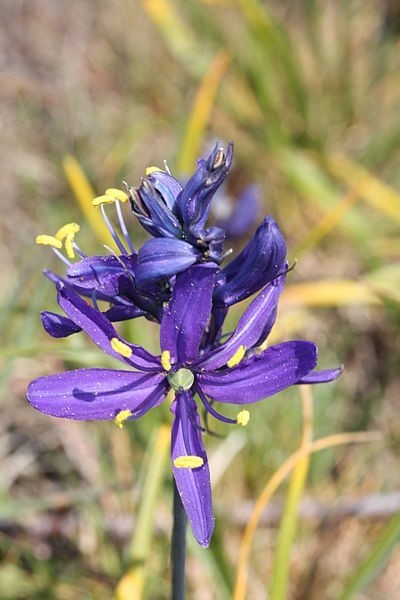
Geographic Distribution: Common from British Columbia through Washington, Oregon, California and Nevada. It grows at elevations below 2,400 m.
Habitat: Grows often in ephemeral habitats that dry out by late spring: meadows, prairies, floodplains, stream sides and moist hillsides.
Pollinators: A large variety of bees and other insects, including Taylor’s Checkerspot (Euphydryas editha taylori).
Mature Height: 71.12 cm
Bloom Period: April through June
Species Facts: Camas was and continues to be one of the most important "root" foods of western North American indigenous peoples, from southwestern British Columbia to Montana, and California. The bulb was greatly valued and widely traded as a major food source. Camas was considered to be one of the most important bulbs to costal California natives.
Eriogonum fasciculatum (California buckwheat)
Eriogonum fasciculatum (Polyganaceae Family) is a common shrub in the southwestern United States. The leaves are leathery, wooly and rolled along the edges. Pink and white flowers grow in dense clusters, attracting honey bees over many months in drier areas. California Buckwheat is a keystone species for sagebrush scrub ecosystems.
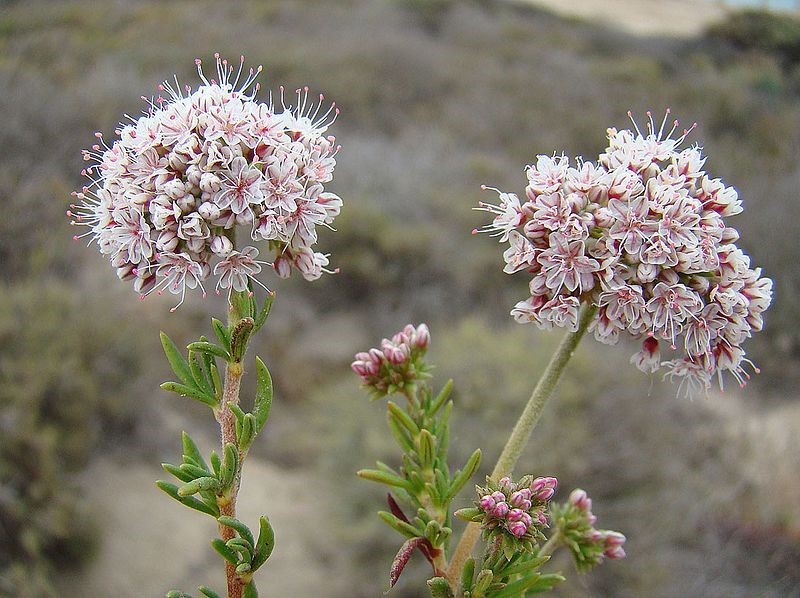
Geographic Distribution: Native to the southwestern United States and northern Mexico.
Habitat: Generally grows in loamy soils on scrubby, south-facing slopes in chaparral regions. Are a common component of Coastal Sage Scrub ecosystems, and may be found inland in Valley Grasslands.
Pollinators: A variety of bees and flies such as the Delhi Sands Flower-loving Fly (Rhaphiomidas terminates abdominalis).
Mature Height: 61 - 201.2 cm
Bloom Period: Spring through fall
Species Facts: The indigenous tribe Cahuilla of Southern California used buckwheat as a medicinal herb for headache, stomach pain, colds and laryngitis. Root and flower poultice was applied to wounds and was commonly taken to prevent heart problems where many Eriogonum species have been identified as being beneficial for heart health.
California Native Plant Society: California-Buckwheat
UC Berkeley: California Buckwheat
Senecio flaccidus var. douglasii (Douglas’ groundsel)
Douglas’ Groundsel (Asteraceae Family) is a variety of the species Senecio flaccidus, a shrub with many arching branches and narrow leaves. The large, bright yellow flowers attract many beneficial insects.
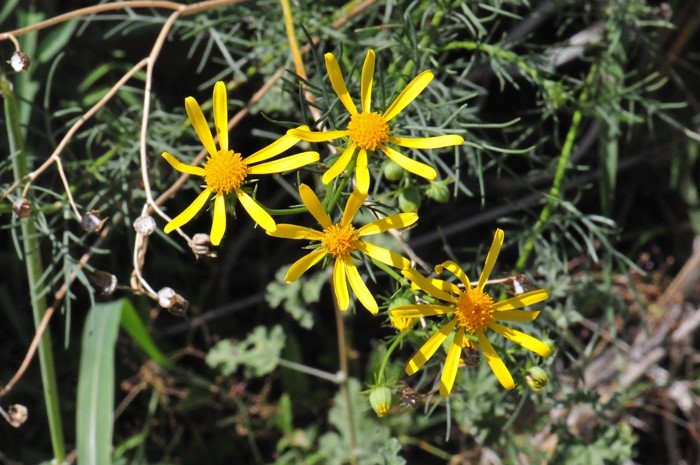
Geographic Distribution: A native shrub of California, most commonly found in central and southern California.
Habitat: Generally grows on disturbed dry, sandy or rocky places, up to about 1,500 m in elevation. It also often grows on streambanks and is common in woodland, sage scrub, and chaparral communities.
Pollinators: A wide range of insects, including Lange’s Metalmark (Apodemia mormo langei).
Mature Height: 152.4 cm
Bloom Period: June to October
Species Facts: Many American Indigenous tribes used Douglas groundsel as a medicinal herb to soothe sore muscles and was a remedy to treat acne and other skin conditions.
California Native Plant Society: Douglas' Groundsel
The Jepson Herbarium: Senecio flaccidus var. douglasii
Calflora: Senecio flaccidus var. douglasii
Southwest Desert Flora: Senecio flaccidus var. flaccidus, Threadleaf Ragwort
Erigeron glaucus (Seaside fleabane/daisy)
Erigeron glaucus (Asteraceae Family) is a perennial wildflower in the daisy family. It has branching, nodding stems that can either be hairy or hairless. It produces spoon-shaped leaves that often have teeth along the edges. Flower clusters of up to 15 flower heads can grow, with golden yellow disc florets in the center and petals that range from deep blue and purple to lavender.
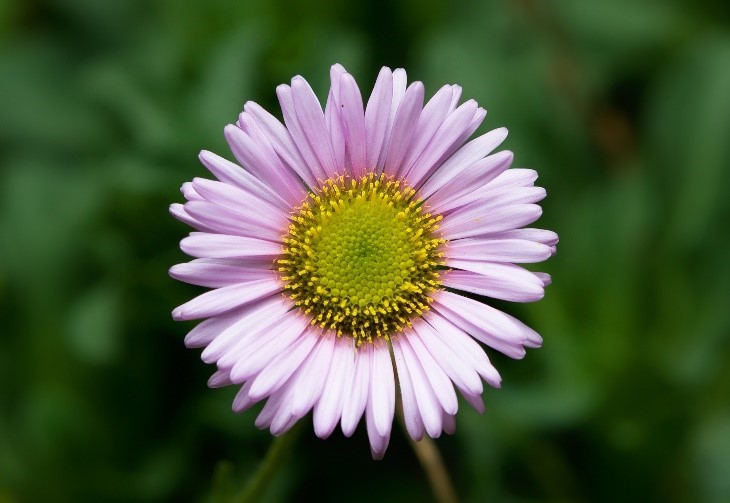
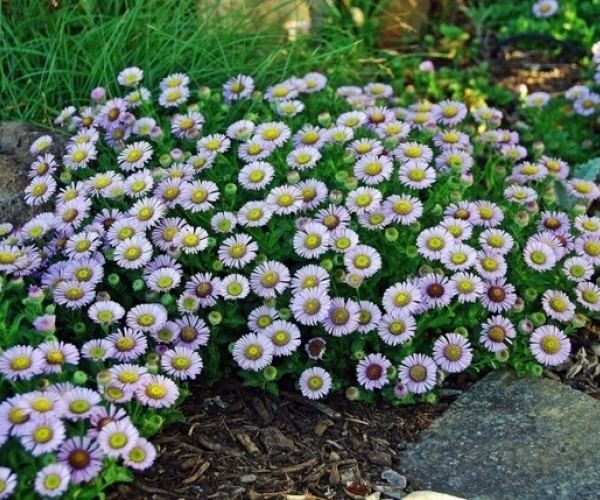
Geographic Distribution: Native to the California and Oregon coastline.
Habitat: Commonly found in clay soils on dunes, beaches and coastal bluffs. Part of the coastal scrub vegetation.
Pollinators: Attracts both bees and butterflies, including Myrtle’s Silverspot (Speyeria zerene myrtleae).
Mature Height: 30.5 cm
Bloom Period: Winter through summer
Species Facts: Erigeron is Greek for "an old man in the spring," referring to the flowers early flowering and fluffy white seed heads.
California Native Plant Society: Seaside Daisy
National Park Service: Seaside Daisy
Liatris pycnostachya (Prairie blazing star)
Liatris pycnostachya (Asteraceae Family) is a perennial herb with tall, course and leafy stems. Nearly half of the stem consists of a dense spike of rose-purple, cylindrical flowers which attract a variety of bees and butterflies. Fuzzy, grass-like leaves cover the lower portion of the stem. This plant is often used ornamentally, or for prairie restoration and landscaping.
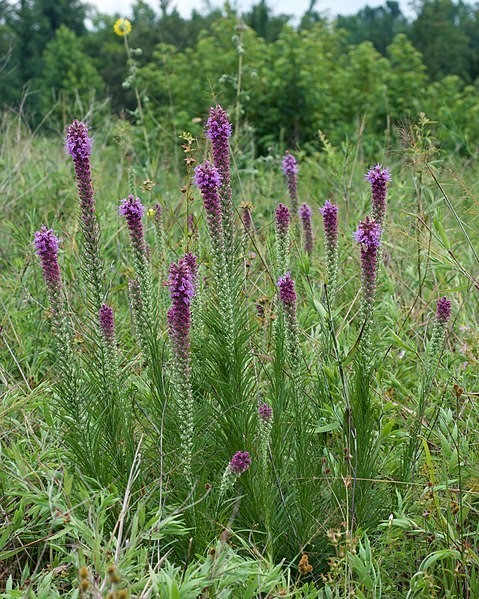
Geographic Distribution: Native to the central and northeast regions of the United States. Habitat Inhabits the prairie biome through tall grasses, damp prairies and open bottomlands.
Pollinators: A wide range of insects, including Pawnee Montane Skipper (Hesperia leonardus montana).
Mature Height: 61 - 152.4 cm
Bloom Period: Mid-summer
Species Facts: The species name, pycnostachya is from the Greek word for “crowded” which describes both the leaves and the densely crowded flower heads.
Lady Bird Johnson Wildflower Center: Liatris pycnostachya
Silene acaulis (Moss campion)
Silene acaulis (Caryophyllaceae Family) is an Arctic perennial evergreen plant. It is highly branched with dense, often hairy leaves that overlap into cushion-like mats. Many solitary flowers grow slightly raised above the rest of the plant, and are generally pink with a yellow band at the base of the petals.
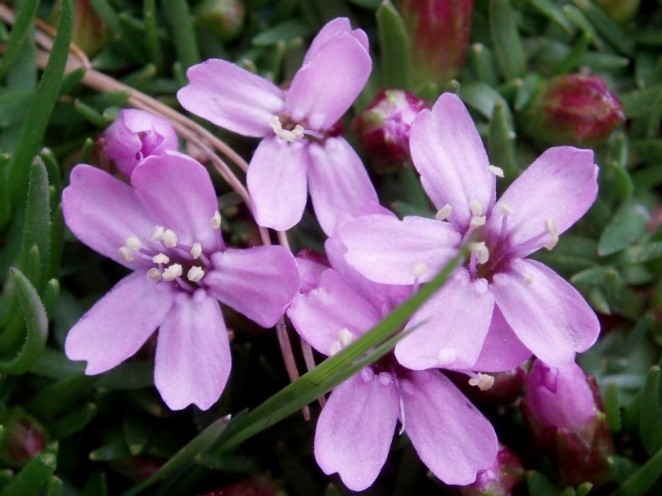
Geographic Distribution: Has a Holoarctic range, spreading in North America from Alaska, through Canada and the northern United States, including Maine and Idaho. It extends into the Rocky Mountains in Colorado, New Mexico, and Arizona.
Habitat: Found in wet areas in meadows, alpine and arctic tundra, and rocky ledges at elevations of up to 4,200 m.
Pollinators: Flies, bees, beetles, moths, and butterflies, including the Pawnee Montane Skipper (Hesperia leonardus montana).
Mature Height: 2.5 - 30.5 cm
Bloom Period: June through August
Species Facts: Moss campion predominately grows in tundra regions, where the word tundra comes from the Finnish word tunturia meaning ‘treeless land’. Above the elevation where trees will grow, Moss campion endures harsh conditions sub-zero temperatures and high winds.
Lady Bird Johnson Wildflower Center: Silene acaulis
Ratibida pinnata (Yellow coneflower)
Ratibida pinnata (Asteraceae Family) is a perennial herb that can grow to more than 91.5 cm in height, and has slender stems with upward pointing hairs. Bright orange-yellow flowers that have 5 - 10 drooping petals and a brown cone in the center grow from the top of each stem. These plants are often grazed by livestock, and can produce an anise scent when damaged.
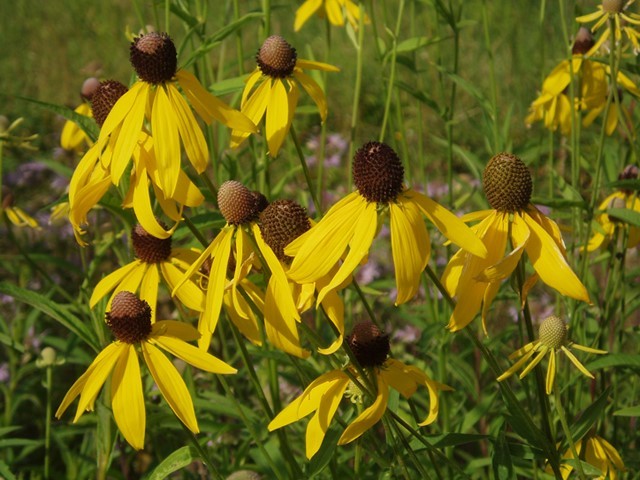
Geographic Distribution: Found in Ontario, Canada and the prairie regions of the central United States, where it extends from Kansas, Oklahoma and Nebraska to the east coast from Vermont to Florida.
Habitat: Associated with prairie regions and often seen along roadsides and woodland edges.
Pollinators: Attracts a wide variety of pollinators, including the Rusty Patched Bumble Bee (Bombus affinis).
Mature Height: 91.5 - 152.5 cm
Bloom Period: May through September
Species Facts: The yellow coneflower is also known as the grey-headed Mexican hat due to the resemblance of the crown of a slender sombrero.
Lady Bird Johnson Wildflower Center: Ratibida pinnata
Missouri Botanical Garden: Ratibida pinnata
Asclepias syriaca (Common milkweed)
Asclepias syriaca (Apocynaceae Family) is a common perennial herb in the milkweed family. It has hairy stems that can either be solitary or branched and hairy leaves with broad, elliptical blades. Flowers bloom in dense inflorescences of 20 - 130 flowers with green/purple flowers and a crown of five erect, rose-purple lobes.
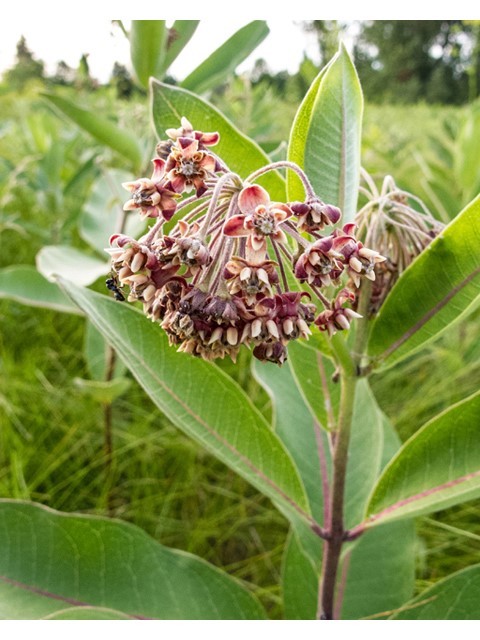
Geographic Distribution: Found through the Great Plains region from southern Canada through the central/eastern regions of the United States.
Habitat: Commonly inhabits the banks of lakes, ponds and waterways along forest margins and prairies.
Pollinators: Milkweed attracts many pollinators such as Monarch, Queen and Viceroy butterflies, as well as milkweed beetles and bees. Is also pollinated by St. Francis’ Satyr (Neonympha mitchellii francisci).
Mature Height: 58-198 cm.
Bloom Period: May to August.
Species Facts: The genus name honors the Greek god Asklepios ‘the god of medicine’ because the plant contains cardiac glycosides used in treating heart disease. These glycosides, when absorbed by monarch butterfly larvae whose sole source of food is milkweed foliage, make the larvae and adult butterflies toxic to birds and other predators.
Lady Bird Johnson Wildflower Center: Asclepias syriaca
Missouri Botanical Garden: Asclepias syriaca
Lady Bird Johnson Wildflower Center: Asclepias syriaca
Agave salmiana (Giant agave)
Agave salmiana (Agavaceae Family) is a perennial, evergreen succulent plant with equal spread and blue-gray, waxy foliage that grows long and broad. Leaves have coarse toothed marginal serrations, and the plant produces a large candelabra inflorescence during its blooming period. The inflorescence can grow to 12 meters in height, and bears small yellow flowers that attract pollinators.
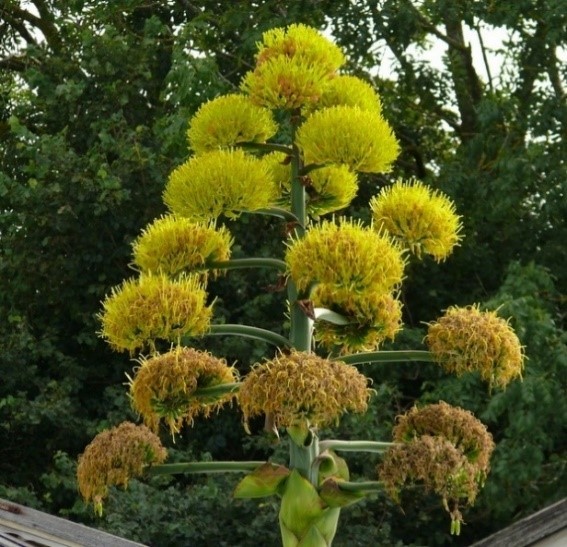
Geographic Distribution: Native to northern and central Mexico uplands. It is now cultivated throughout many warm regions of the lower United States and the world.
Habitat: Grows in semi-arid to arid zones, thriving in partial sunlight/filtered live and soil with adequate drainage. Can grow in relatively cold zones (-7.8 to -3.8 °C).
Pollinators: Various species of birds, hummingbirds and bees visit Agave salmiana, as well as the Mexican Long-nosed Bat (Leptonycteris nivalis).
Mature Height 2.5 - 3 m
Bloom Period: Summer
Species Facts: When the plant matures after 20 years of growth it blooms only once. The tall candelabra inflorescence rises to more than 6 m bearing yellow flowers that attracts birds and bees. Agave nectar (more accurately called agave syrup) can be extracted from Agave salmiana and is a sweetener commercially produced and has been marketed as a “healthful” sweetener. It is a true vegan alternative to honey and generally is sweeter than pure sugar.
Arizona State University: Agave salmiana
Trees Planet: Agave Salmiana – Giant Agave
The Bubbly Professor: Five Fast Facts about Agave
Stachytarpheta jamaicensis (Blue porterweed)
Stachytarpheta jamaicensis (Verbenaceae Family) is a short-lived perennial shrub that is distinguishable by its trailing stems and dark green, lance-shaped leaves. It produces showy, blue or purple flowers on long, stringy spikes at the ends of its stems that attract pollinators. As it grows to about 1 year old, it becomes woody towards the base of the stem.
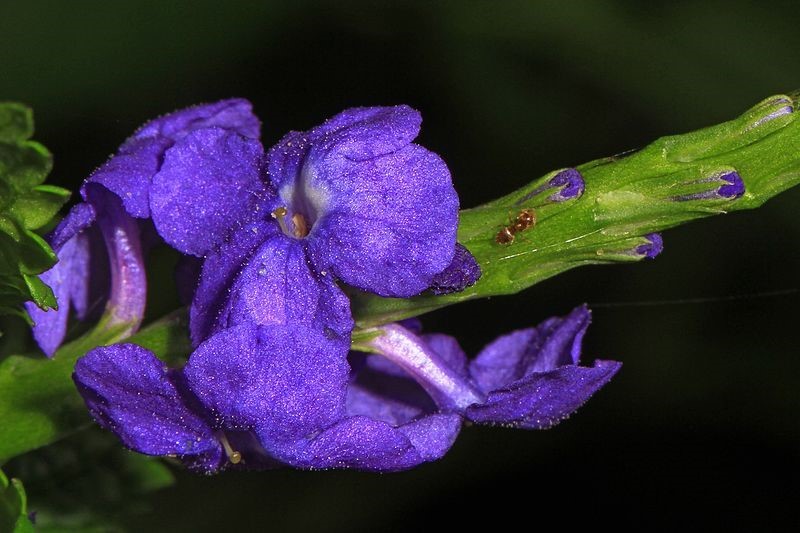
Geographic Distribution: Grows in southern Florida and the Florida Keys. It is also found in other regions of Florida, Puerto Rico, and tropical/oceanic areas of the world.
Habitat: Commonly found in coastal strand, open areas in dry mesic hardwood forests, and sometimes along sandy roadsides.
Pollinators: Bees, hummingbirds, and butterflies, including Schaus Swallowtail (Heraclides aristodemus ponceanus).
Mature Height: 1.2 - 2.4 m
Bloom Period: Summer to fall
Species Facts: The common name is taken from the Greek stachys, meaning "spike," and tarphys, meaning "thick," referring to the thickened flower spike typical of the genus.
Florida Native Plant Society: Stachytarpheta jamaicensis
Heliotropium curassavicum (Seaside heliotrope)
Heliotropium curassavicum (Boraginaceae Family) is a perennial herb that can act as either a prostrate creeper or an erect shrub. It has a fleshy stem and thick, oval or spade-shaped leaves. Inflorescences produce curled rows of small, bell-shaped flowers that are lavender to white with a purple or yellow center.
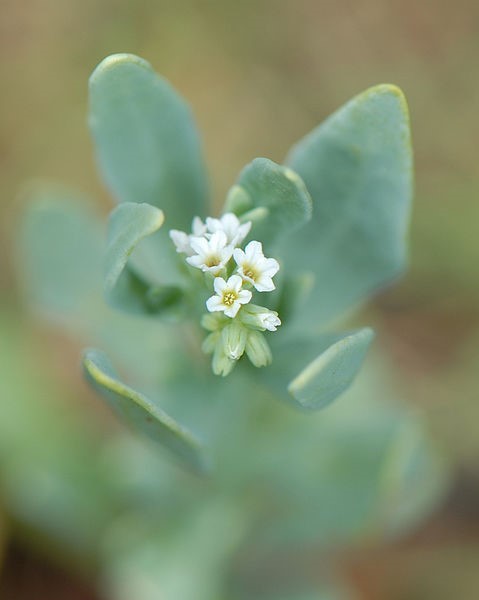
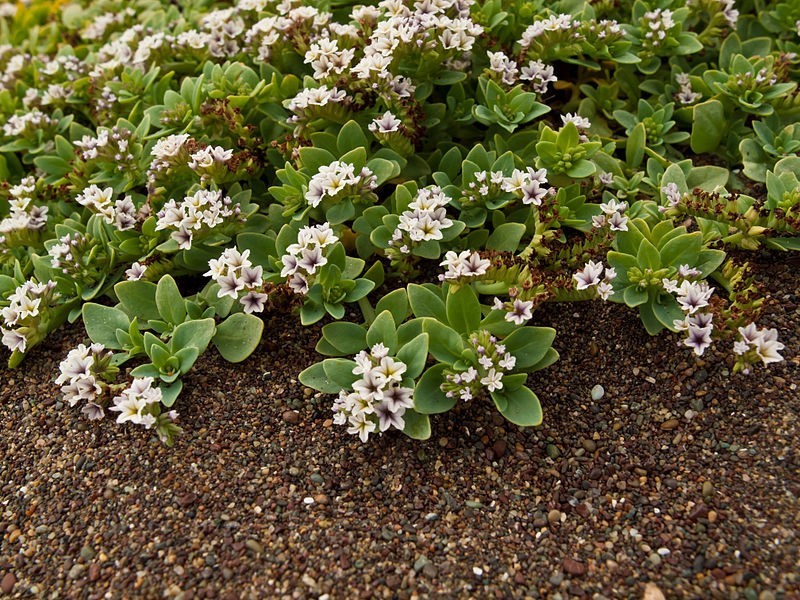
Geographic Distribution: Native to most of the Americas from Canada to Argentina.
Habitat: Grows in salty and alkaline soils, such as beach sand and alkali flats. It’s highly polymorphic character allows it many ecological variants.
Pollinators: Bees and butterflies, including the Miami Blue (Cyclargus thomasi bethunebakeri).
Mature Height: 36.5 - 49 cm
Bloom Period: Spring
Species Facts: Seaside Heliotrope produces organic compounds called pyrrolizidine alkaloids (PAs) which are developed by the plant as a defense mechanism. PAs are toxic in high concentrations to many insects and some vertebrates, including humans, which offers protection against grazers.
California Native Plant Society: Seaside Heliotrope
Yucca glauca (Soapweed yucca)
Yucca glauca (Agavaceae Family) is an evergreen shrub with short, branching stems and a taproot. The plant produces long, conclave leaves with coarse fibers along the edges. The steep angle of the leaves allow for year-round photosynthesis, and the plant produces a long inflorescence composed of 25 to 30 drooping flowers ranging from yellow-green to lavender.
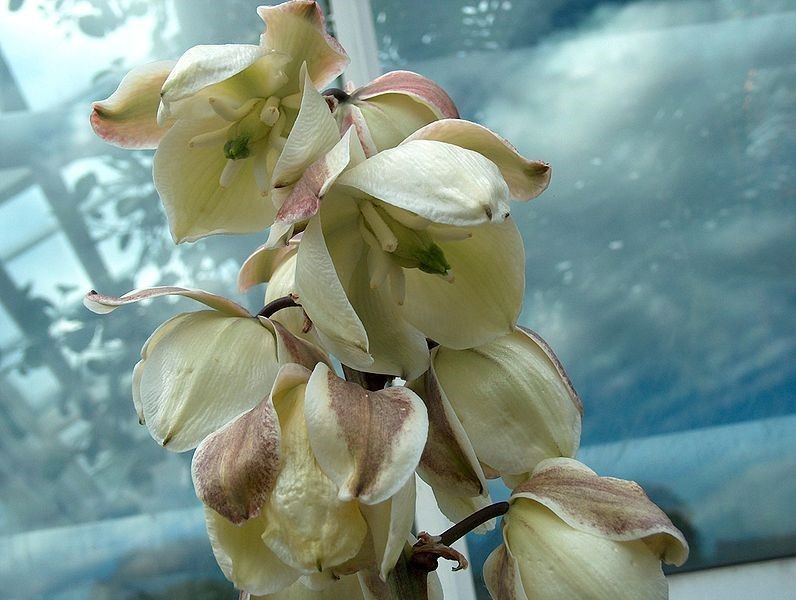
Geographic Distribution: A widespread yucca species, soapweed yucca is found through the Great Plains, from Alberta to southeastern New Mexico, and east into Iowa and Arkansas.
Habitat: Commonly found on sandy or rocky areas, limestone soils, and on hills, plains, and rocky outcrops. Can inhabit elevations up to 2,600 m and can withstand variable temperatures characteristic of its habitat.
Pollinators: Pollinated by small flies (Pseudocalliope spp.), but primarily depends on pollination from the Yucca Moth (Pronuba yuccasella).
Mature Height: 92 cm
Bloom Period: May through June in New Mexico, and May through July in the Great Plains.
Species Facts: American Indigenous tribes used soapweed yucca medicinally to treat inflammation and poison ivy rashes. The root was traditionally used to make soaps for hair washing, preventing hair loss, and to kill lice.
Lady Bird Johnson Wildflower Center: Yucca glauca
Solidago canadensis (Canada goldenrod)
Solidago canadensis (Asteraceae Family) is a long-lived perennial in the sunflower family. It has smooth stems that are covered in fine hairs and hairy, lance-shaped, toothed leaves. Inflorescences grown on one side of long, drooping panicle branches produce between 10 and 17 flowers, attracting a variety of pollinating insects. It is often used to provide pollinator habitat in North America and for rangeland revegetation of disturbed areas.
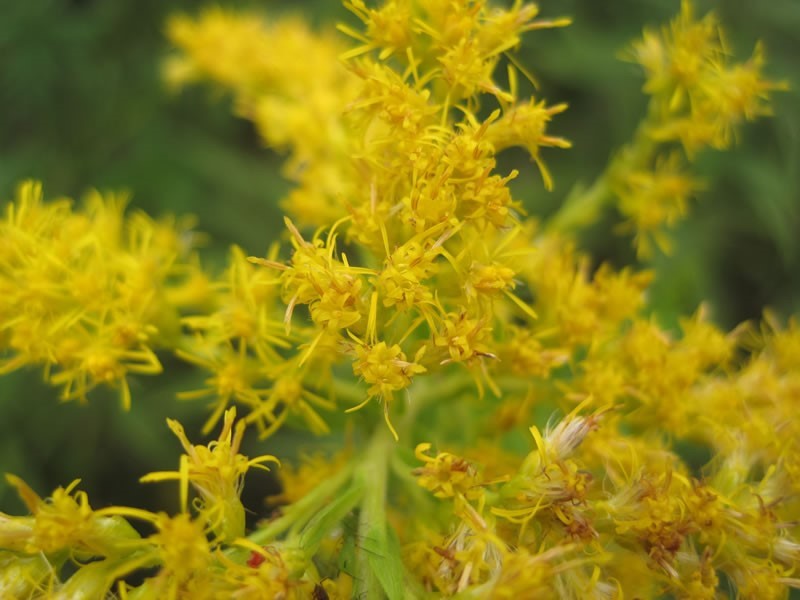
Geographic Distribution: Grows widely in most US states and all Canadian provinces besides Nunavut.
Habitat: Typically found in moist soil amongst damp meadows, waterways, and roadside ditches. They can also inhabit open slopes in upland prairies, and deciduous and evergreen forests.
Pollinators: A variety of insects including the Yellow-Banded Bumble Bee (Bombus terricola).
Mature Height: 2.2 m
Bloom Period: July through October
Species Facts: Canada goldenrod has been most commonly used to make tea. Among indigenous tribes this tea was used specifically to help with diarrhea, but as well during the American Revolution is was used as a substitute for highly taxed English tea.
Capital Naturalist: Goldenrod Safari
Ladeania lanceolata (Lance-leaf scurf pea)
Ladeania lanceolate (Fabaceae Family) is a perennial plant with tall, freely branching stems. It has trifoliate leaves with elliptic leaflets, and dense inflorescences with 10 - 40 pea-like, white to gray-blue flowers. Native populations used this plant medicinally for sore throats, dry skin and stomach illnesses.
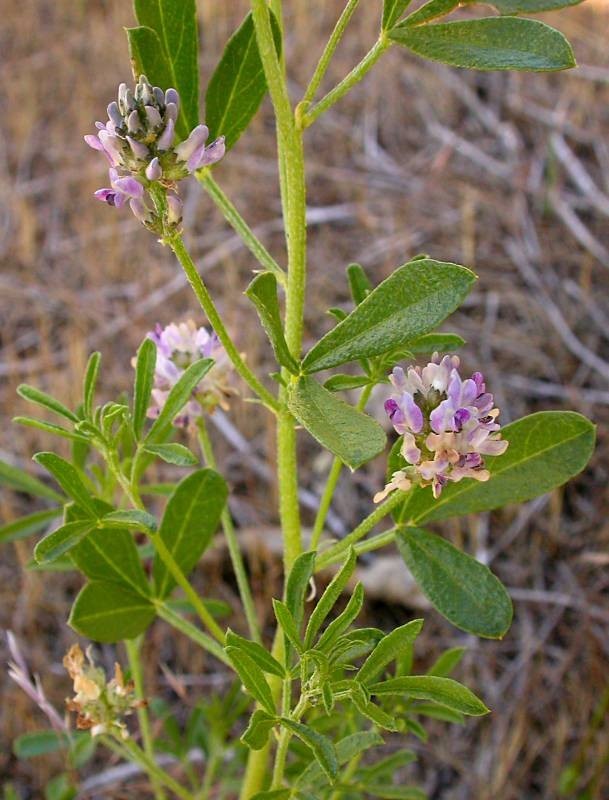
Geographic Distribution: Found from eastern Washington to southern California, east to the central regions of Canada and the United States.
Habitat: Inhabits sagebrush habitat in dry, sandy areas. Can also inhabit prairies, sand dunes and mixed-sandy flood plains.
Pollinators: Bees, butterflies, and moths, including the Dusky Dune Moth (Copablepharon longipenne).
Mature Height: 10 - 82 cm
Bloom Period: May through July
Species Facts: American Indigenous groups rubbed the oily leaves on the skin for dryness, chewed fresh leaves for sore throats and roots for hoarseness, and took a cold infusion of the plant to treat stomachaches.
Burke Herbarium: Ladeania lanceolata
Kansas Wildflower & Grasses: Lemon Scurf-Pea
Limonium carolinianum (Sea lavender)
Limonium carolinianum (Plumbaginaceae Family) is a small, perennial herb. Its green leaves form in basal rosettes with a tapered base and ascending lateral veins. Its inflorescences grow in loosely aggregated spikelets, with 1 - 3 lavender/white flowers per spikelet.
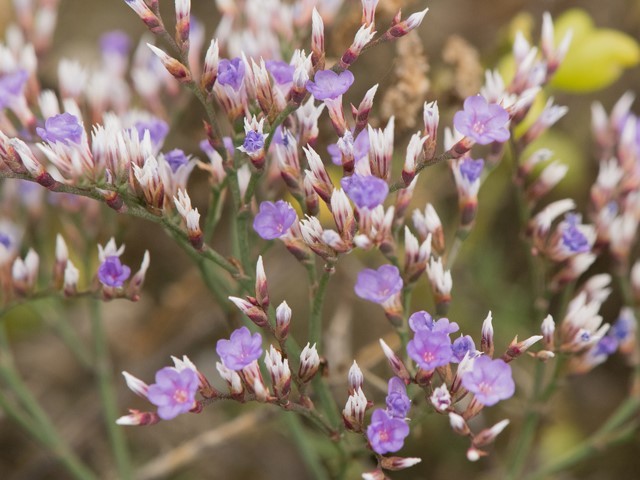
Geographic Distribution: Grows from northern Mexico throughout the southern and eastern coastline of the United States, up through southeastern Canada and Quebec.
Habitat: Found along tidal marshes, and is often associated with other marsh plants that scatter among marsh grasses.
Pollinators: Bees and butterflies, including the Maritime Ringlet (Coenonympha nipisiquit).
Mature Height: 30 cm
Bloom Period: June through August
Species Facts: The roots have astringent properties that can be a very powerful medicine to treat diarrhea, cankers and can be applied to old ulcers.
Lady Bird Johnson Wildflower Center: Limonium carolinianum
Practical Plants: Limonium carolinianum
Clusia salvinii (La flor de la canela)
Clusia salvinii (Clusiaceae Family) is a small tree or terrestrial shrub that may sometimes be epiphytic (meaning they can grow on other plants). Rounded leaves with lateral nerves grow on a cuneate base, and inflorescences produce numerous creamy-white flowers.
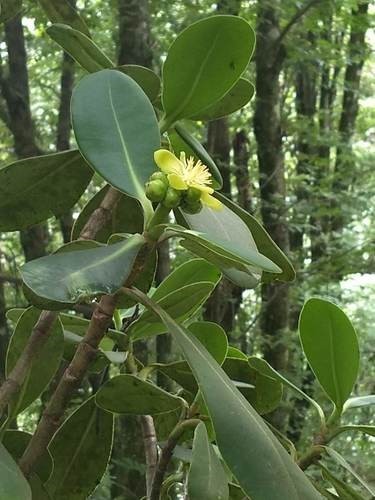
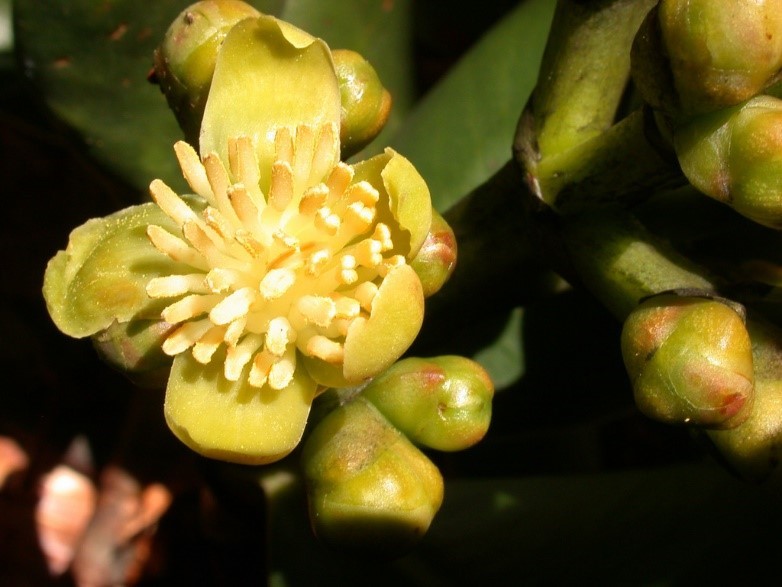
Geographic Distribution: Found in ranges between Mexico and Panama.
Habitat: Inhabits evergreen forests and cloud forests at altitudes of 915 - 1,981.2 m
Pollinators: Bees, wasps, and hummingbirds, including the Short crested coquette (Lophornis brachylophus).
Mature Height: 2 - 4 m
Bloom Period: Spring and summer
Species Facts: Commonly grown in Spanish speaking countries, this plant is known as ‘la flor de la canela’ or ‘the cinnamon flower’ due to its pungent aroma. It can also be used to make a tea to help clarify the blood for inflammatory ailments.
Flora de Nicaragua: Clusia salvinii
Encyclopedia of Life: Clusia salvinii
Lobelia laxiflora (Mexican cardinal flower)
Lobelia laxiflora (Campanulaceae Family) is a perennial evergreen herb. It produces red-yellow flowers in tubular shapes that attract hummingbirds.

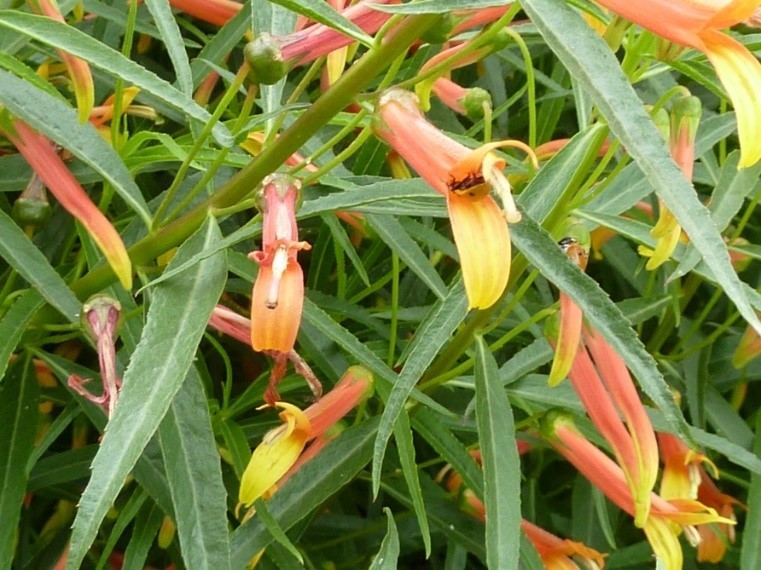
Geographic Distribution: Native to the Americas, where it is distributed in South, Central, and North America as far north as Arizona in the United States.
Habitat: Tends to thrive in forest habitats or riparian woodlands.
Pollinators: Hummingbirds, such as the Blue-capped Hummingbird (Eupherusa cyanophyrus).
Mature Height: Usually grows up to about 1.5 m in maximum height, but known to reach up to 3 m.
Bloom Period: Spring through fall
Species Facts: Like other lobelias, this species contains medicinally useful alkaloids to prevent the inflammatory process.
The National Gardening Association: Mexican Cardinal Flower (Lobelia laxiflora)
National Library of Medicine: Phytochemical study and antiinflammatory properties of Lobelia laxiflora L
The Pollinators
Hylaeus anthracinus (Yellow-faced Bee)
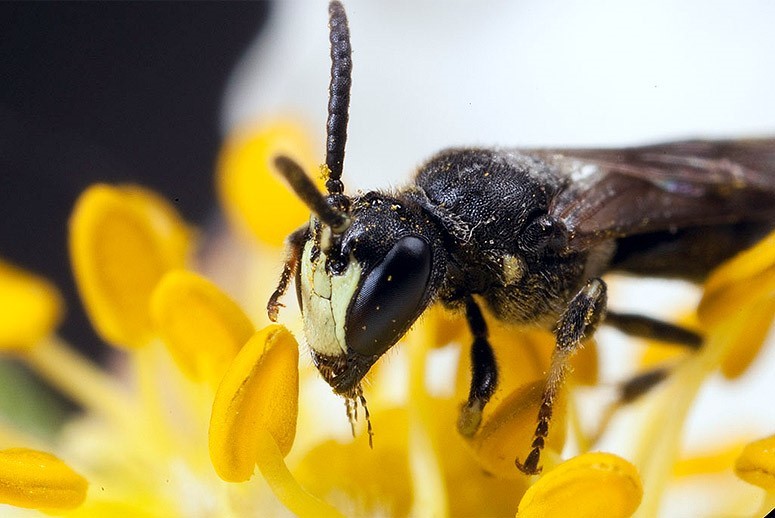
Geographic Distribution: Restricted to small patches of habitat on each island in Hawaii. Its largest stretch is an area of sand dunes on Molokai; it is also found in small patches on Oahu, Kahoolawe, Maui, and Hawaii.
Habitat: Inhabits coastal lands, and occasionally found at higher elevations in dry forests. It is thought to nest in stems of coastal shrubs.
Size Identification: Characterized by a single large facial mark, often filling the entire area below the antennae. Males have a fully yellow clypeus, whereas females are entirely black. Both sexes possess black abdominal hairs.
Plants Commonly Visited: Sesbania tomentosa, Chamaesyce celastroides var. kaenana.
USA State Status: Species of Concern.
NatureServe Conservation Status: GNR
Species Facts: H. anthracinus is the first species of bees to receive protection on the Endangered Species List. The biggest threat to the Yellow-faced Bee is habitat loss. Native coastal strand vegetation is now extremely rare and human development and introduced plants have severely reduced available habitat
U.S. Fish & Wildlife Service: Hylaeus anthracinus
iNaturalist: Anthracite Masked Bee
Palmeria dolei (Akohekohe, or Crested Honeycreeper)
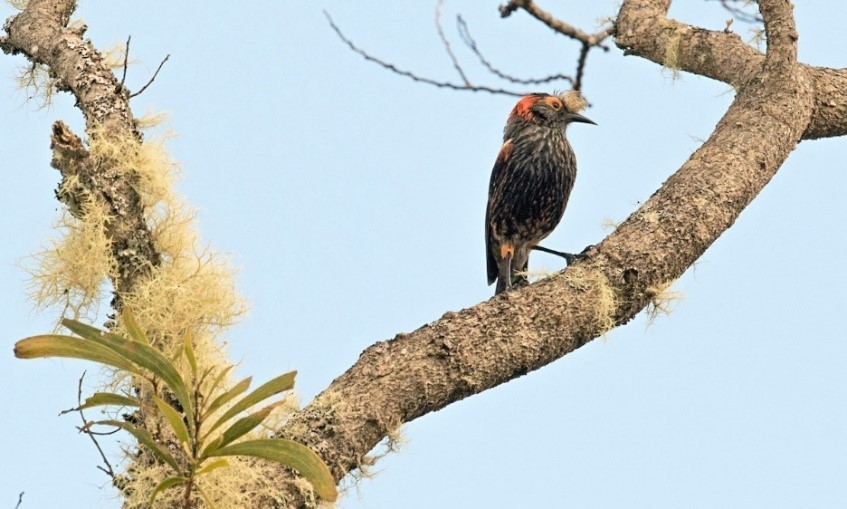
Geographic Distribution: Currently found on east Maui, Hawaii, from Waikamoi Preserve to Kipahulu and Manawainui valley. Formerly inhabited the island of Moloka’i, but is now extinct there.
Habitat: Inhabits misty, high-elevation rainforests at about 1,300 - 2,300 m
Size: 18 cm in length and is the largest of the honeycreepers on Maui.
Identification: Characterized by black plumage and bright feathers of orange-scarlet and silver. Its nape is also a bright orange-scarlet. Adults bear a bushy, white crest of feathers over the bill, giving the species its English name “Crested Honeycreeper.” It gives a distinctive call from its habitat along rainforest treetops, where the Hawai’ian name “Akohekohe” is derived. It is considered Critically Endangered, and is threatened by habitat loss.
Plants Commonly Visited: Primarily feeds on the nectar of Ohi’a (Metrosideros polymorpha). Is also documented to feed upon Vaccinium calycinum and Rubus hawaiiensis when Ohi’a is not available.
USA Endangered Species Act Status: Endangered
IUCN Red List Status: Critically Endangered
NatureServe Conservation Status: G1 – Critically Imperiled
Species Facts: They got their name due to their crested feathers as well as because of the way they creep around when sipping nectar from their favorite blossoms.
NatureServe Explorer: Akohekohe
The Website of Everything: Crested honeycreeper
Manduca blackburni (Blackburn's Sphinx Moth)
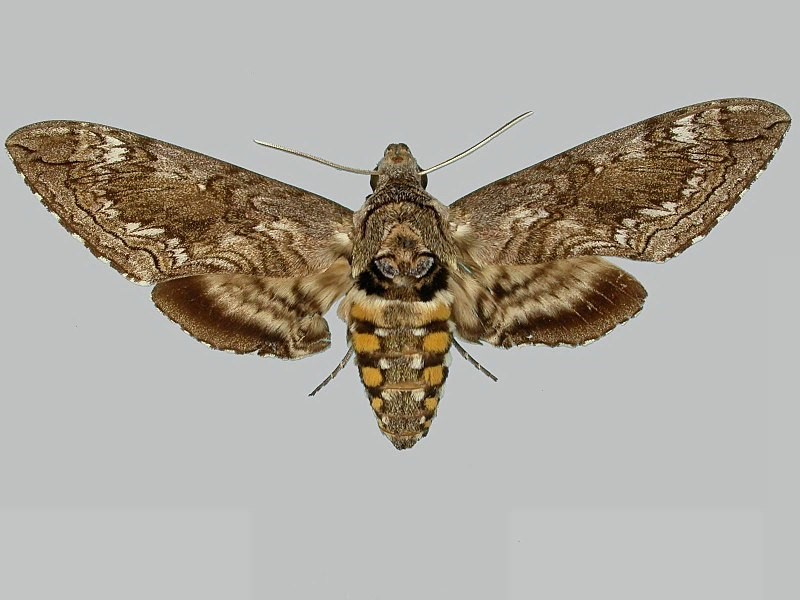
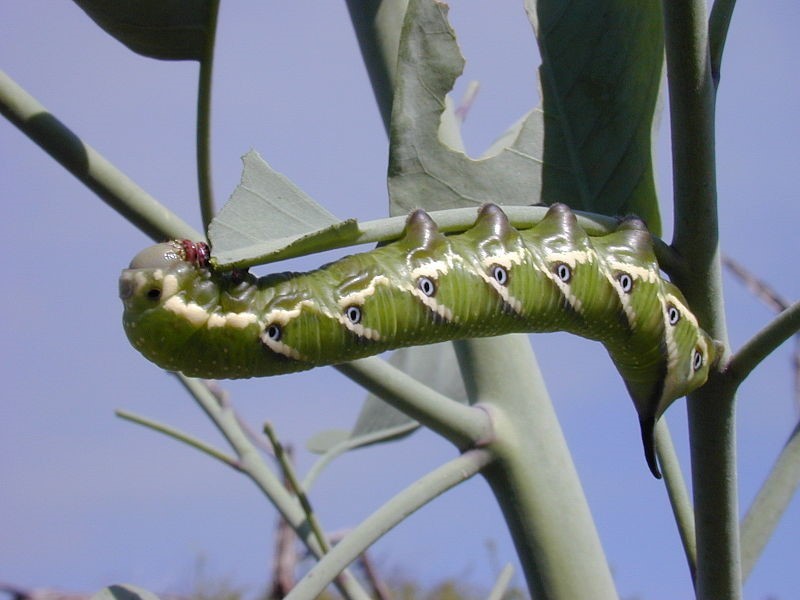
Geographic Distribution: Currently restricted to tracts of dry forest on Hawai’i, Maui, and Kaloowahe. Historically, it was found on five of the largest Hawai’ian islands, and probably inhabited all seven major islands.
Habitat: Commonly found in lowland dry forests and shrub lands.
Size: Wingspan of up to 13 cm
Identification: A large, grayish-brown sphingid hawk moth. It has long, narrow forewings and a thick, spindle shaped body. Black bands appear across the tops of the hindwings, and five orange spots can be found on each side of the abdomen. The moth’s caterpillar is large and can be found in two morphs: gray or bright green.
Plants Commonly Visited: Adult moths have been documented feeding on nectar of Ipomoea indica, Capparis sandwichiana, and Plumbago zeylanica.
USA Endangered Species Act Status: Endangered
NatureServe Conservation Status: G1- Critically Imperiled
Species Facts: In the 1970s it was believed that Blackburn’s sphinx moth was extinct. However, it was rediscovered in 1984 when a single population was found on Maui. Since then, populations have also been discovered on Kaho’olawe and Hawaii.
NatureServe Explorer: Manduca blackburni
Department of Land and Natural Resources: Blackburn's Sphinx Moth
Drepanis coccinea (I’iwi, or Scarlet Honeycreeper)
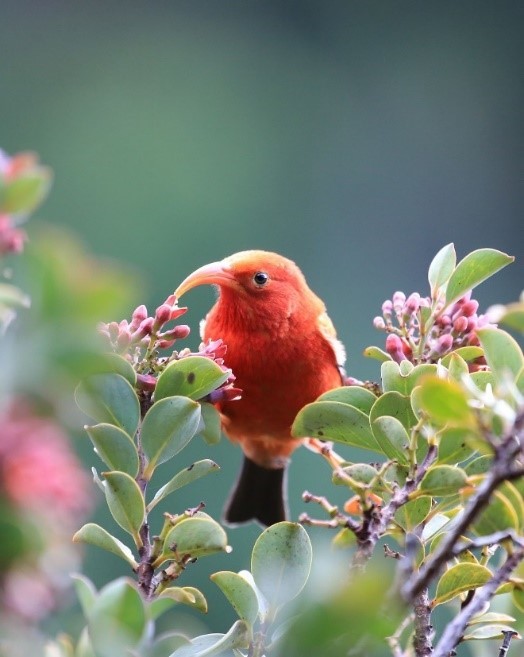
Geographic Distribution: Commonly found on Maui, Hawai’i, and Kaua’i, and is rare on Oah’u and Moloka’i. Populations are extirpated on Lana’i.
Habitat: Often found defending territory in flowering Ohi’a trees. Inhabit forests where Ohi’a and Lobelias are present, and move often between favorable feeding areas.
Size: 15 cm
Identification: A vermillion red songbird with a prominently decurved bill. The species is sexually monomorphic, and adults are bright red with black wings and tail, with contrasting white patches on the inner wings. The decurved bill is peach or salmon colored.
Plants Commonly Visited: Metrosideros polymorpha and Clermontia arborescens.
USA Endangered Species Act Status: Threatened
IUCN Red List Status: Vulnerable
NatureServe Conservation Status: G4 - Apparently Secure
Species Facts: In pre-European Hawai‘i, beautiful feather capes, sometimes containing hundreds of thousands of ‘I‘iwi feathers, were a symbol of power and prestige among native Hawaiians.
Euphydryas editha taylori (Taylor’s Checkerspot)
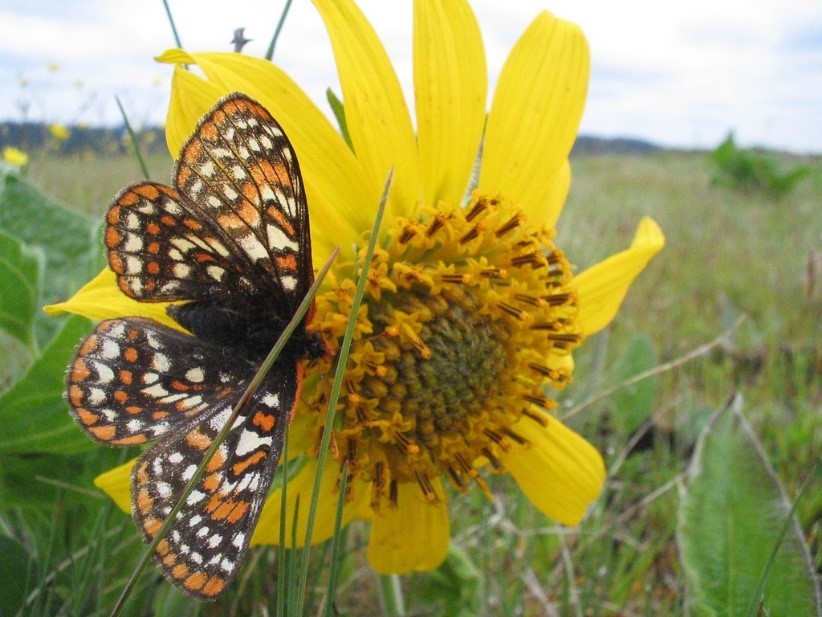
Geographic Distribution: Historical populations existed from Oregon’s Willamette Valley up through south Vancouver Island in British Columbia. Populations in BC have been extirpated, and the species is now only found at 12 sites in Washington and two in Oregon.
Habitat: Inhabits oak balds and open grasslands.
Size: Wingspan less than 6 cm
Identification: A medium-sized, colorful, checkered butterfly, and the darkest subspecies of the Edith checkerspot. The dorsal wing surface displays a mixture of black, orange and white and has stubby, round wings. The dorsal side of the wings have a larger proportion of black separating the spots than other subspecies.
Plants Commonly Visited: Documented feeding on members of the Scrophulariaceae family, Castilleja hispida, and several species of plantains.
USA Endangered Species Act Status: Endangered
Canadian Species at Risk Act Status: Endangered
NatureServe Conservation Status: G5T1- Critically Imperiled
Species Facts: Taylor’s Checkerspot is the darkest subspecies of Euphydryas editha due to their wings. Compared to other subspecies, they have the stubbiest and roundest wings.
Rhaphiomidas terminatus abdominalis (Delhi Sands Flower-Loving Fly)
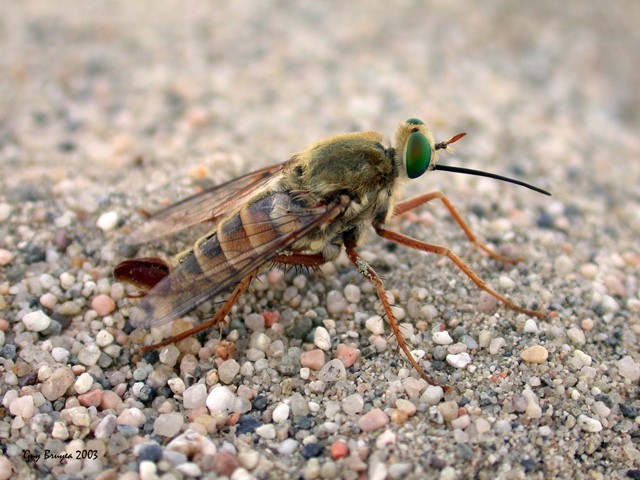
Geographic Distribution: Found within an 8-mile radius in southwestern San Bernadino and northwestern Riverside counties in California. It was once known to have occurred through a 65 km radius in the Colton Dunes.
Habitat: Inhabits sandy soils, often within wholly or partially consolidated dunes. Indicated by its namesake, it is restricted to a particular soil type classified as the “Delhi” series.
Size: 2.5 cm
Identification: A large fly with orange-brown/black coloration and dark brown oval spots. It has a long, tubular proboscis that it uses to extract nectar from flowers.
Plants Commonly Visited: Documented to feed on flowers of Eriogonum fasciculatum.
USA Endangered Species Act Status: Endangered
NatureServe Conservation Status: G1T1- Critically Imperiled
Species Facts: This is the only fly presently on the Endangered Species List. The Delhi Sands habitats are highly unusual and are not found anywhere else on earth. Scientists have compared the Delhi Sands flower-loving fly to a flagship for the whole Delhi Sands ecosystem.
PBase.com: Delhi Sands Flower-loving Fly
UC Berkeley: Delhi Sands Flower-loving Fly
Apodemia mormo langei (Lange’s Metalmark)
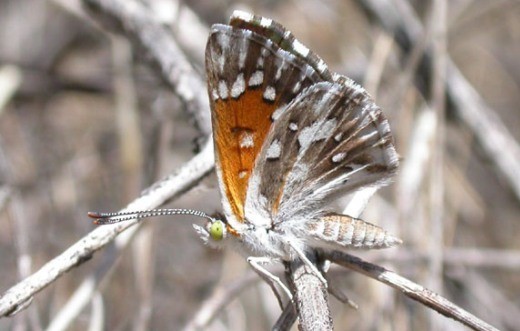
Geographic Distribution: Historically found in sand dunes along the southern bank of the San Joaquin River. Currently, is only found at the Antioch Sand Dunes in Contra Costa County, CA.
Habitat: Riverbank and sand dunes. Most of the butterfly’s original sand dune habitat has been lost
Size: Adult wingspan varies from 2.5 - 3.8 cm
Identification: A brightly colored butterfly whose dorsal wings are black with white spots. Red-orange coloration extends from the hindwings, through a small central patch and upon the inner forewings.
Plants Commonly Visited: Known to feed upon buckwheat species such as Eriogonum nudum and Senecio flaccidus var. douglasii, as well as San Joaquin snakeweed (Gutierrezia californica). Lange's Metalmark butterfly also use silver lupine (Lupinus albifrons) for mating.
USA Endangered Species Act Status: Endangered
NatureServe Conservation Status: G5T1 – Critically Imperiled
Species Facts: The California Endangered Species Act does not allow listing of insects, so despite its precarious status, Lange’s Metalmark has no protection under state legislation. The California Department of Fish and Game includes this butterfly on its Special Animals list.
Speyeria zerene myrtleae (Myrtle’s Silverspot)
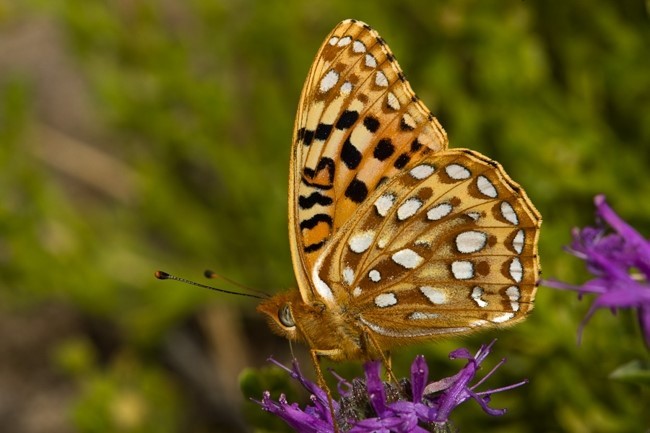
Geographic Distribution: Historically found in dunes and bluffs from San Mateo county north to the mouth of the Russian River. Urban development has extricated southern populations, and currently the species is only found in western Marin and southwestern Sonoma counties.
Habitat: Inhabits coastal dune and prairie habitats, and associated non-native grassland habitats. Usually found within 4.8 km of the coast below 247 m in elevation.
Size: Wingspan is approximately 5.6 cm
Identification: A medium sized butterfly with wings of golden brown coloration and numerous black spots and lines. The ventral surfaces are brown to tan with black lines and distinctive silver and black spots. This subspecies is larger and slightly lighter than its close relative, Behren’s silverspot.
Plants Commonly Visited: Adults commonly visit Grindelia hirsutula, Abronia latifolia, Monardella spp., Cirsium vulgare, and Erigeron glaucus.
USA Endangered Species Act Status: Endangered
NatureServe Conservation Status: G5T1- Critically Imperiled
Species Facts: A major threat to Myrtle’s Silverspot is loss of habitat due to development or vegetation change. Changes in natural fire patterns, introduction of exotic plants, and successional changes in the plant community and grazing have reduced the availability of host plants. Silverspot butterfly larvae are also extremely sensitive to pesticides.
Earth.com: Speyeria zerene myrtleae
Hesperia leonardus montana (Pawnee Montane Skipper)
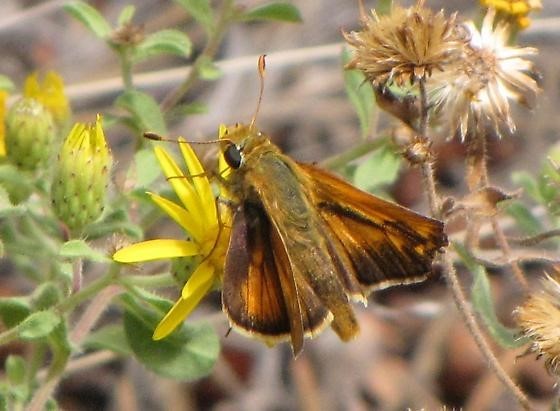
Geographic Distribution: Occurs within a 61 km radius on the Pikes Peak Granite Formation of the South Platte River system in Colorado.
Habitat: Inhabits dry, open Ponderosa pine woodlands between 1,800 - 2,300 m
Size: Average wingspan of about 3.2 - 4.5 cm
Identification: A large butterfly in the family Hesperiidae. It has brownish-red colorations on the dorsal wing service, with distinct yellow spots on the outer margins.
Plants Commonly Visited: Liatris pycnostachya is its primary adult nectar plant.
USA Endangered Species Act Status: Threatened
NatureServe Conservation Status: G4T1- Critically Imperiled
Species Facts: In 1987, the Pawnee Montane Skipper was listed on the Federal Endangered Species List as a Threatened species. The reason for this listing was caused by habitat loss over the last 120 years of fire suppression as well as the growth of conifers and loss of grasslands containing their feeding plants.
Bug Guide: Pawnee Montane Skipper
Cornell University: Hesperia leonardus Montana, Pawnee Montane Skipper
Boloria acrocnema (Uncompahgre Fritillary)
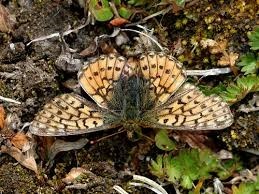
Geographic Distribution: Currently confined to small habitat patches in the San Juan Mountains of Colorado. Historically, it was believed to be broadly distributed near glacial margins during the Wisconsin glaciation.
Habitat: Lives above the tree line of alpine meadows and moist tundra with dwarf willows at altitudes above 4,000 m.
Size: Wingspan is approximately 3.2 cm
Identification: A small butterfly in the Nymphalidae family. Its dorsal wing is dull orange-brown with lighter shading towards the body, and black markings that fear faded and indistinct.
Plants Commonly Visited: Most commonly visits Silene acaulis.
USA Endangered Species Act Status: Endangered
NatureServe Conservation Status: G5T1- Critically Imperiled
Species Facts: There are various threats to this species including illegal collecting and increased recreation activities in the high mountains add to the pressure on this butterfly. The possibility that global warming will result in an altitudinal retreat of habitat continues to threaten colonies of this butterfly.
Journal of the Lepidopterists' Society: Oviposition Behavior and Larval Biology of the Endangered Uncompahgre Fritillary Boloria Acrocnema (Nymphalidae)
Bombus affinis (Rusty Patched Bumble Bee)
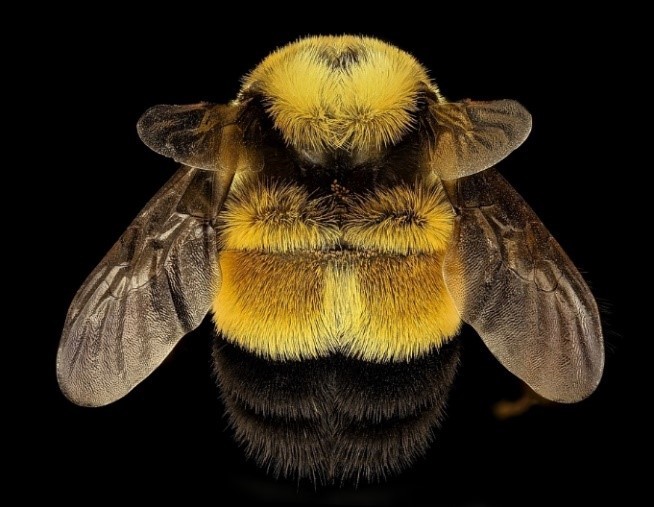
Geographic Distribution: Formerly inhabited the eastern coast of the United States and extended west through the Midwest towards Minnesota and North Dakota. However, current populations inhabit only a fraction of this region.
Habitat: As generalists, bumble bees do not depend on any specific flower type. They can range along multiple habitats and are able to fly in cooler temperatures than many other bees. They are important pollinators of many flowering plants and crops.
Size: Queens can range from 20 - 22 mm in length and 9 - 11 mm in width where workers are about 10 - 16 mm in length and 6 - 9 mm in width.
Identification: One of many species of bumble bees. Akin to its name, it is characterized by a distinct rusty patch on the front half of their second abdominal segment. Black hairs extend from the center of the thorax out towards the wings and centrally in a narrow V towards the rear. Queens and males differ slightly in coloration from worker bees.
Plants Commonly Visited: Known to visit Gentiana prostrata and Silene acaulis, along with many species of crops and wildflowers.
USA Endangered Species Act Status: Endangered
NatureServe Conservation Status: G1- Critically Imperiled
Species Facts: Bombus affinis perform a behavior called “buzz pollination” in which the bee grabs the pollen producing structure of the flower in the jaws and vibrates the wing musculature causing vibrations that dislodge pollen that would have otherwise remained trapped in the flower’s anthers. Some plants, including tomatoes, peppers, and cranberries, require buzz pollination.
Xerces Society: Rusty Patched Bumble Bee
Montana State University: The conservation biology of the Uncompahge fritillary and the related northern dingy fritillary
U.S. Fish & Wildlife Service: Rusty Patched Bumble Bee
Neonympha mitchellii francisci (St. Francis’ Satyr)
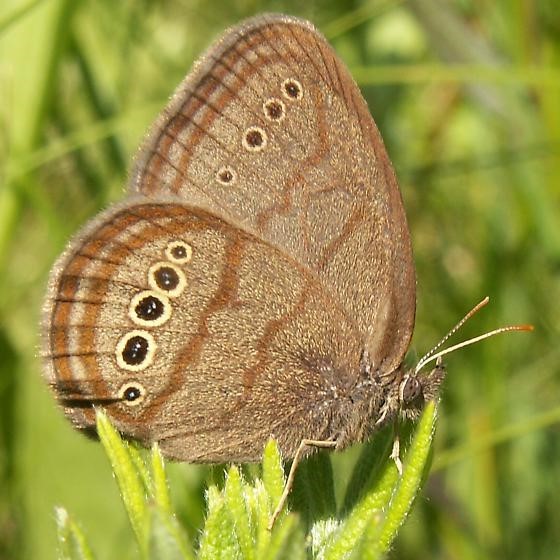
Geographic Distribution: Known to exist on Fort Bragg in the sand hills of North Carolina, and a single record was found in 1998 for its residency in Virginia.
Habitat: Inhabits wide, wet meadows dominated by sedges and other wetland flora.
Size: 3.4 - 4.4 cm
Identification: A small, dark brown butterfly with distinctive eye spots on the lower surfaces of its wings. The spots have dark-brown centers with lighter, opalescent patches. Two bright orange bands line the posterior wing edges, and two darker orange bands line the central portion of each wing.
Plants Commonly Visited: Asclepias incarnata, Asclepias syriaca, Achillea millefolium, Daurus carota, and Coronilla varia.
USA Endangered Species Act Status: Endangered
NatureServe Conservation Status: G1G2T1- Critically Imperiled
Animal Diversity Web: Neonympha mitchellii
Leptonycteris nivalis (Mexican Long-Nosed Bat)
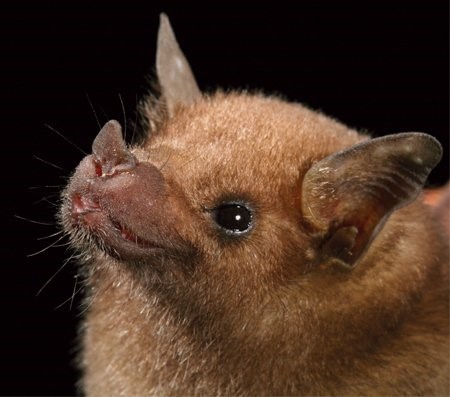
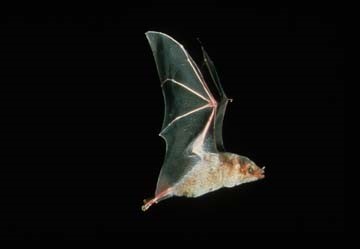
Geographic Distribution: Found in southwestern New Mexico, the Big Bend area of Texas, the Chinati Mountains of Presidio County, Texas and southward to central Mexico.
Habitat: Inhabits riparian zones, desert scrub, conifer-oak woodlands, and pine forests. Most occurrences in Mexico are at 1,000 - 2,195 m in elevation.
Size: Forearm 5.5 - 6.6 cm
Identification: Dark gray to brown in color, and has a long muzzle with a prominent nose leaf at the tip. Its long tongue, an adaptation for feeding on flower nectar, extends up to 7 cm and has hair-like papillae on its tip. It has a minute tail that may appear to be lacking.
Plants Commonly Visited: Commonly feeds on nectar and pollen of at least 21 plant species, including Agave salmania.
USA Endangered Species Act Status: Endangered
NatureServe Conservation Status: G3- Vulnerable
Species Facts: They are very strong, highly maneuverable fliers, and like hummingbirds, are able to hover in flight while they feed. Their tongue can extend up to 7 cm, which is impressive for a bat that is only 9 cm long.
NatureServe Explorer: Leptonycteris nivalis
Texas Parks & Wildlife: Mexican Long-nosed Bat
Reddit: The tongue of the endangered Mexican Long-nosed Bat (Leptonycteris nivalis) can extend 7cm, which is pretty impressive for a bat that is only 9cm long!
Heraclides aristodemus ponceanus (Schaus Swallowtail)
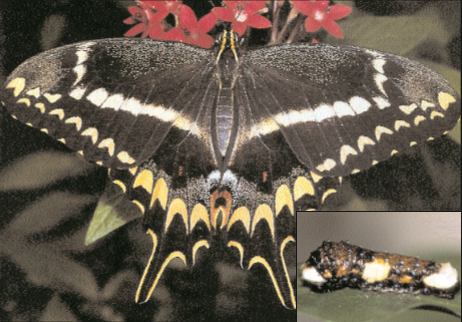
Geographic Distribution: Concentrated in the insular portions of Miami-Dade and Monroe counties in Florida and also found in Puerto Rico. Current populations are found only from Key Biscayne Park to northern Key Largo and Upper Matecumbe Key.
Habitat: Inhabits subtropical dry forests and hardwood hammocks, including areas that have been regrown after former clearing for arming.
Size: Approximately 9 cm
Identification: A large, dark brown butterfly in the Papilionidae family. The tails are solid brown with a yellow border and a narrow, yellow wing band. Males have yellow-tipped antennae.
Plants Commonly Visited: Adults feed on the nectar of Psidium guajava, wild tamarind, and Morinda royoc, as well as Stachytarpheta jamaicensis.
USA Endangered Species Act Status: Endangered.
NatureServe Conservation Status: G3G4T1- Critically Imperiled
Species Facts: Schaus Swallowtail are capable of flying as far as 5.8 km in a day and can travel across open waters for a considerable distance.
Cyclargus thomasi bethunebakeri (Miami Blue)
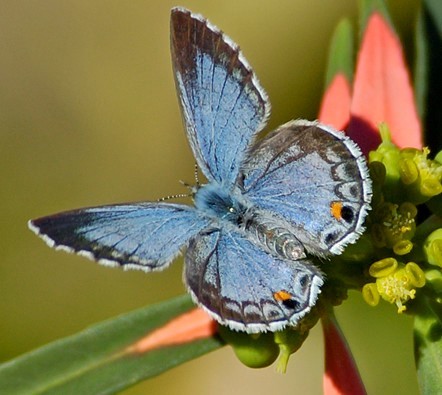
Geographic Distribution: Historically found from south Florida to the Keys, but current populations have been reduced to a small colony site in the Lower Florida Keys.
Habitat: Inhabits tropical hardwood hammocks, scrub, and pine rocklands.
Size: 2.2 - 2.8 cm
Identification: A small butterfly in the Lycaenidae family. These adult butterflies are sexually dimorphic meaning that the two sexes of the same species show different characteristics besides from their sexual organs. In the case of the Miami Blue, the color markings are varied where males have metallic blue dorsal wings, whereas females have primarily grey wings with blue scaling and orange-black eyespots. Larvae can range in color from light green to maroon.
Plants Commonly Visited: Many plants have been listed as a nectar source for the Miami Blue in the Key West National Wildlife Refuge, including Heliotropium curassavicum.
USA Endangered Species Act Status: Endangered
NatureServe Conservation Status: G3G4T1 – Critically Imperiled
Species Facts: The major threats to this species include the loss of habitat in coastal regions due to urban development. Mosquito control pesticides, applied via spraying the air is also a cause for the decline and recovery of this species.
JSTOR: Discovery of the Imperiled Miami Blue Butterfly (Cyclargus thomasi bethunebakeri) on Islands in the Florida Keys National Wildlife Refuges, Monroe County
University of Florida: Miami blue butterfly
North American Butterfly Association: Miami Blue Chapter
Tegeticula yuccasella (Yucca Moth)

Geographic Distribution: Ranges through the Great Plains from southern Canada to southern Texas, and across all regions to the Eastern seaboard and Puerto Rico. The only sustainable population in Canada is in Alberta at Onefour.
Habitat: The yucca moth is native to the southwestern United States and Mexico. The Sonoran Desert region is home to approximately ten species of yucca plant, and where there are yucca plants, there are yucca moths. Yucca moths are also found in the southeastern portion of the U.S. and the West Indies, where just one species of yucca plant is known to exist.
Size: 1.8 - 2.8 cm
Identification: A small, white moth closely associated with Yucca flowers. They possess specialized mouthparts to actively pollinate their host species. Distinction between closely related species is difficult without microscopic examination.
Plants Commonly Visited: This species is the primary pollinator of soapweed, Yucca glauca.
COSEWIC Status: Endangered.
Species Facts: The female Yucca Moth collects pollen, forming a compact ball that is three times the size of her head which she transports to other yucca flowers. The yucca moth is one of the oldest moth species and Yucca plants would not exist without the yucca moth and vice versa.
Bombus terricola (Yellow-banded bumble bee)
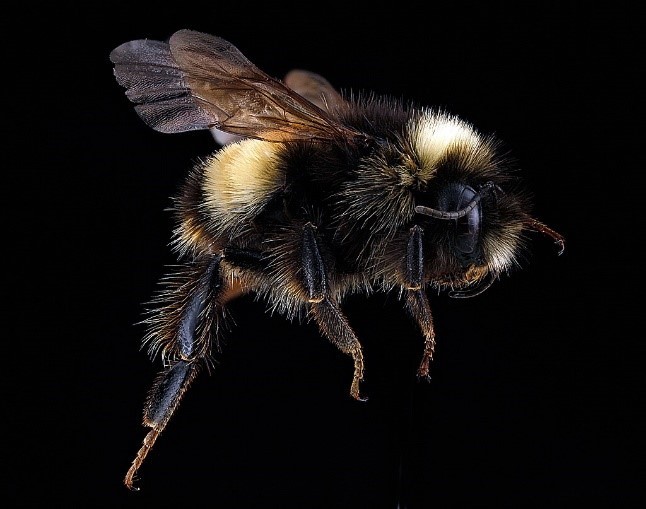
Geographic Distribution: Historical populations ranges from eastern Montana and Alberta through to the east coast, with a southern extension along the Appalachian Mountains. Current populations are restricted to a few locations in Wisconsin and a single location in Pennsylvania (records dating 2007 and 2006, respectively).
Habitat: Inhabits a diverse range of mixed woodlands, farmlands, urban areas, montane meadows, prairie grasslands, boreal habitats.
Size: Queens are about 19 - 21 mm, workers 10 - 15 mm, males 13 - 15 mm
Identification: Queens and workers have yellow on the front part of the thorax, as well as the second and third abdominal segments. The rest of the hair is primarily black, except for a brown-yellow fringe of hairs on the fifth abdominal segment. Male coloration is similar, with the exception of pale yellow hair on the front of the face and top of the head (female heads are nearly entirely black).
Plants Commonly Visited: Pollinates a variety of wild and agricultural plants, including Solidago canadensis.
USA Endangered Species Act Status: Currently undergoing a status review for potential listing
COSEWIC Status: Special Concern.
NatureServe Conservation Status: G3- Vulnerable
Species Facts: When most insects are inactive due to cold temperatures bumble bees are able to fly by warming their flight muscles by shivering, enabling them to raise their body temperature as necessary for flight.
Bombus occidentalis (Western Bumble Bee)
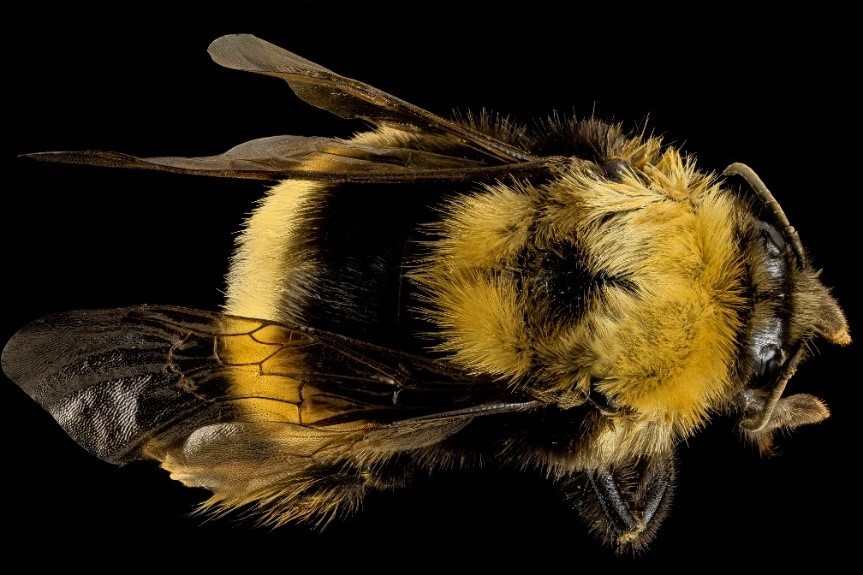
Geographic Distribution: Ranges through most of western North America, from the west coast through southern Saskatchewan and South Dakota.
Habitat: Inhabits a diverse range including woodlands, farmlands, urban areas, montane meadows and prairie grasslands.
Size: 1 - 2 cm
Identification: One of five North American members of the subgenus Bombus sensu stricto. It is characterized by a short head and a transverse band of yellow hair on the thorax. The tip of its abdomen is almost always white.
Plants Commonly Visited: Pollinates a variety of plants including Solidago canadensis.
USA Endangered Species Act Status: Currently undergoing a status review for potential listing
COSEWIC Status: Threatened.
IUCN Red List Status: VU – Vulnerable.
Species Facts: Bumble bees are effective buzz pollinators of several economically important plants in the family Solanaceae such as tomato, bell pepper and eggplant. In buzz pollination bees extract pollen from a flower by vibrating against the flower’s anthers, making an audible buzzing noise.
NatureServe Explorer: Bombus occidentalis
iNaturalist: Western Bumble Bee
Copablepharon longipenne (Dusky Dune Moth)
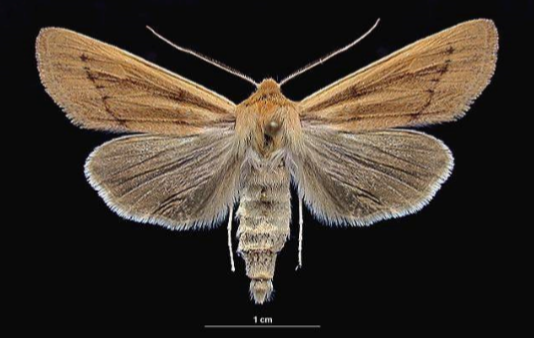
Geographic Distribution: Copablepharon longipenne ranges across the Great Plains, and is found from southern Manitoba, Saskatchewan, and Alberta, to western Texas and southern New Mexico.
Habitat: Its specialized habitat lies in active, sparsely vegetated sand dunes.
Size: Adults are sexually dimorphic in size: forewing length averages 16.5 mm (range 11 – 19 mm) in males and 18.5 mm (range 17 – 20 mm) in females.
Identification: A medium-sized, light brown moth. Forewings have a pale streak with a prominent line of small black dots, and hindwings are brown-grey. Caterpillars have a grey base with brown-red stripes, and a distinctly bluish ventral surface.
Plants Commonly Visited: Likely not restricted to a single nectar plant, but has been documented pollinating Ladeania lanceolata.
COSEWIC Status: Endangered.
Species Facts: Copablepharon longipenne is closely associated with active sand dunes, a regionally rare habitat in the southern Canadian and Northern US prairies. It can be considered a focal species representing the sensitivity and uniqueness of this habitat type in Canada.
Coenonympha nipisiquit (Maritime Ringlet)
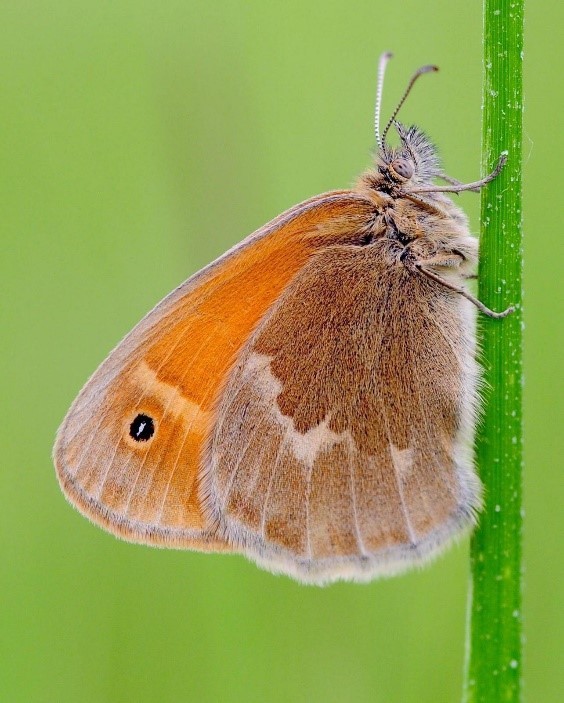
Geographic Distribution: Range is restricted to Chaleur Bay in northern New Brunswick and the coast of the Gaspe Peninsula in Quebec.
Habitat: Inhabits salt marshes throughout its entire life cycle, but adults may feed on flowers in neighboring habitats.
Size: 3.2 - 3.6 cm
Identification: A small, dark butterfly in the Nymphalidae family. Males have a dark ochre front wing with a greyish border, and an eyespot is present in about one third of males. The underside of the back wing is brown with an olivaceous, grey cast towards the top. Females have an eyespot much more commonly, and are more ochre-colored.
Plants Commonly Visited: Feeds primarily on sea lavender, Limonium carolinianum.
COSEWIC Status: Endangered.
Species Facts: Maritime Ringlet populations are declining predominately because of sea level rise and damages to salt march ecology. Toxic chemicals in waterways such as industrial sewage or effluent, disturb their reproduction and habitat balance.
BirdsEye Photography: Maritime Ringlet
Lophornis brachylophus (Short-crested Coquette)
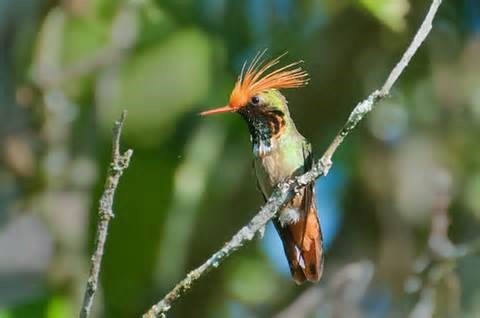
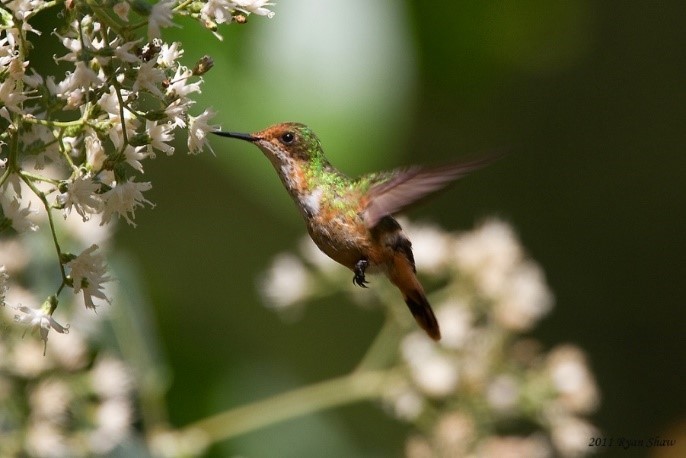
Geographic Distribution: Restricted to a 25.8 km stretch of the Atoyac-Paraiso-Puerto del Gallo road in the Sierra Madre del Sur of Guerrero, Mexico.
Habitat: Inhabits subtropical or tropical montane forest and plantations. They rely on humid evergreen forest, semi-deciduous, forest, pink-oak forests, and plantations.
Size: 7 - 7.6 cm
Identification: A small hummingbird that weighs approximately 2.8 gm. Males have bronze-green upperparts with rufous crown and crest. A white band is apparent on the upper rump, and the lower rump is bronze-purple. It has a green throat and short, orange cheek-tufts. Females appear similar, but lack the crest and cheek patches.
Plants Commonly Visited: Documented to visit Clusia salvinii.
IUCN Red List Status: Critically Endangered.
Species Facts: The Short-crested Coquette is threatened by habitat loss due to land clearing for agricultural purposes. This hummingbird is omnivorous, eating fruit, nuts, and occasionally small amphibians like worms.
iNaturalist: Short-crested Coquette
Birds of the World: Short-crested Coquette
Eupherusa cyanophrys (Blue-capped Hummingbird)
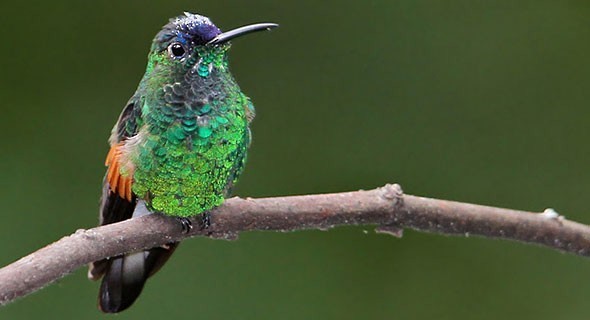
Geographic Distribution: Endemic to the Sierra Miahuatlan, a mountain range in Oaxaca, Mexico. It’s current known range is highly restricted.
Habitat: Inhabits cloud-forests and the upper reaches of tropical semi-deciduous forests at 1,300 - 1,950 m in elevation. It may occasionally wander beyond this elevation range.
Size: Approximately 11 cm
Identification: A small hummingbird with a distinctive green coloration. Males have a turquoise-blue crown and a white undertail, and females have a green crown with white postocular spots and grey ear-coverts.
Plants Commonly Visited: Feeds on the nectar of Lobelia laxiflora, as well as species of Inga, Kohleria, Lobelia, Malviscus, Manettia, and Psittacanthus.
IUCN Red List Status: Endangered.
Species Facts: The forests they inhabit are being cleared for agriculture, consequently causing the decline of this hummingbird's population.
IUCN Red List: Oaxaca Hummingbird
Birds of the World: Blue-capped Hummingbird
eBird: Blue-capped Hummingbird
Credits
Science Advisors
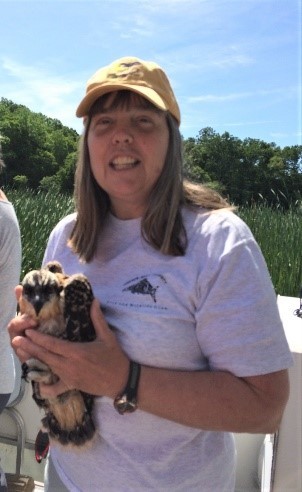
Karen Anderson works within the FWS Headquarters Ecological Services program Branch of Recovery, Conservation Planning, and Communications focusing on candidate species issues related to the Endangered Species Act and have worked for the Service for more than 25 years. Karen coordinates with the regions on issues and policy related to candidate agreements (CCAs and CCAAs) and Safe Harbor Agreements (SHA) for ESA-listed species.

Dr. Ma. del Coro Arizmendi is a professor at Universidad Nacional Autónoma de México and is the Coordinator of the Graduate Program in Biology of UNAM. She is the teacher of 54 courses at UNAM, has 52 papers published in journals and is the Author of seven books and 31 book chapters both national and internationally published. Coro is the Mexican Steering Committee Chair of the North American Pollinator Protection Campaign.
Dr. William Carromero is the National Botanist for the USDA Forest Service. Dr. Carromero’s work at the Forest Service national headquarters includes support and implementation of native plant material policy for revegetation and restoration work to improve ecosystem diversity and support pollinators. William serves on the North American Pollinator Protection Campaign Steering Committee.

Dr. Gary Krupnick is the head of the Plant Conservation Unit in the Department of Botany, National Museum of Natural History at the Smithsonian Institution in Washington, D.C. His research examines how data from herbarium specimens can be used in assessing the conservation status of plant species. Gary serves on the Steering Committee of the North American Pollinator Protection Campaign.

Dr. Vicki Wojcik has been working to protect and promote pollinators with Pollinator Partnership since 2011. As Research Director she oversees P2’s research program, keeping on top of new and emerging pollinator issues and managing a program set that includes pollinator habitat conservation and landscape management assessments; understanding and enhancing agroecosystems; landuse and pesticide policy review; support for threatened and critical species; and ecosystem service assessments. Vicki serves as the Canadian Steering Committee Chair of the North American Pollinator Protection Campaign.
About the Artist - Carol Schwartz

A passion for art and nature has inspired Carol Schwartz her whole life. As a child growing up in Kansas City, Missouri, Carol was fascinated with animals and had a constant supply of drawing materials. She earned her BFA through attending the Kansas City Art Institute and Rhode Island School of Design. In 2014 she received her MFA from the University of Hartford in Connecticut. Her illustrations have appeared in more than 60 picture books, mostly science related nonfiction, and countless magazines, newspapers, and advertisements. Her books have been chosen as Outstanding Science Trade Books by the National Science Teacher’s Association and Children’s Book Council and have been honored with the Children’s Choice Book Award and the Original Art exhibition at the Society of Illustrators in New York. Her artwork is exhibited throughout the country, including The Society of Illustrators in New York and Focus on Nature XIV and XV.
Relying on imagination and design, Carol tells a story of the fascinating details and beauty of nature. Her work is done with a combination of traditional and digital media, working in Photoshop. Gouache, an opaque watercolor, is her favorite traditional medium because of its versatility in application as a translucent wash or as opaque color. The intense color that can be achieved with gouache is also part of its appeal. Carol finds satisfaction in creating texture and details to add interest and accurate information. This communicates a deeper understanding of a subject and helps the viewer connect better with what they see.
Carol enjoys teaching and speaking about her nature inspired work and her artistic process at schools, libraries, and conferences. She teaches at Eastern Connecticut State University and New Hampshire Institute of Art. As a member of the Guild of Natural Science Illustrators, particularly in New England, she is involved in a community of artists devoted to visually documenting the natural world.
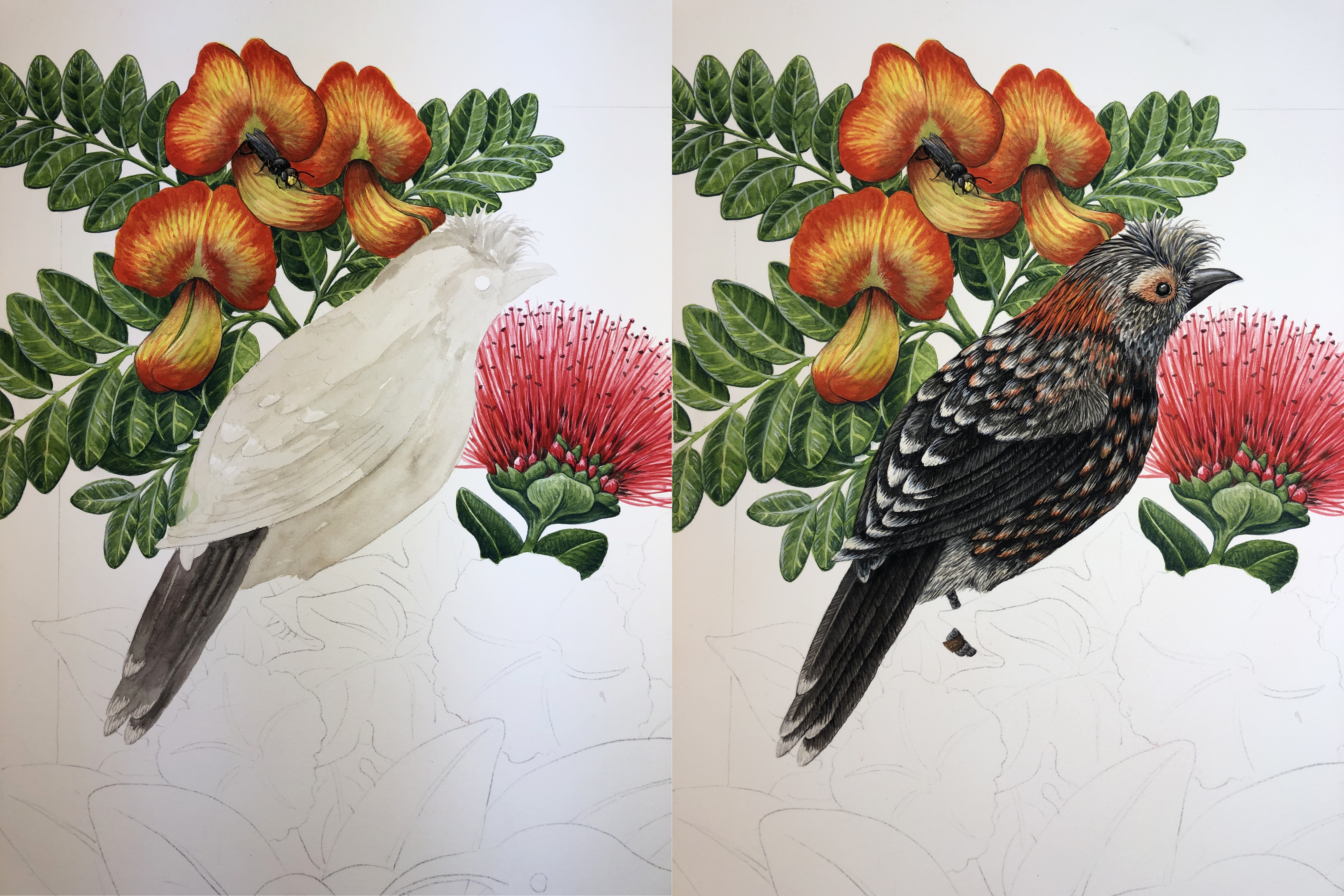
My first step in creating the 2019 Pollinator Partnership poster was intense research about the long list of endangered pollinators. There was much discussion about which species to show. Unfortunately, there are many. Eventually the list was narrowed down to 22 endangered pollinators. I needed to find out what they looked like from all angles and learn more about them. The same method was used for each endangered plant species.
I made a small rough sketch of how I wanted to arrange each species. Using geographic location as a guide, I arranged the species with those from Hawaii on the left, then Western North America, Central North America and finally Eastern North America. I had to keep in mind that there must be room for captions along the way. Also, as I was arranging the subjects I had to think about color and arrange each subject so there would be good color balance. I made a rough color sketch using colored pencils to help see the full color picture.
Because the poster was so large I decided to create the work in two parts and assemble them in Photoshop. The Hawaiian species are on one board and the rest on another. I worked on Strathmore 3-ply Bristol Board and painted each species using gouache.
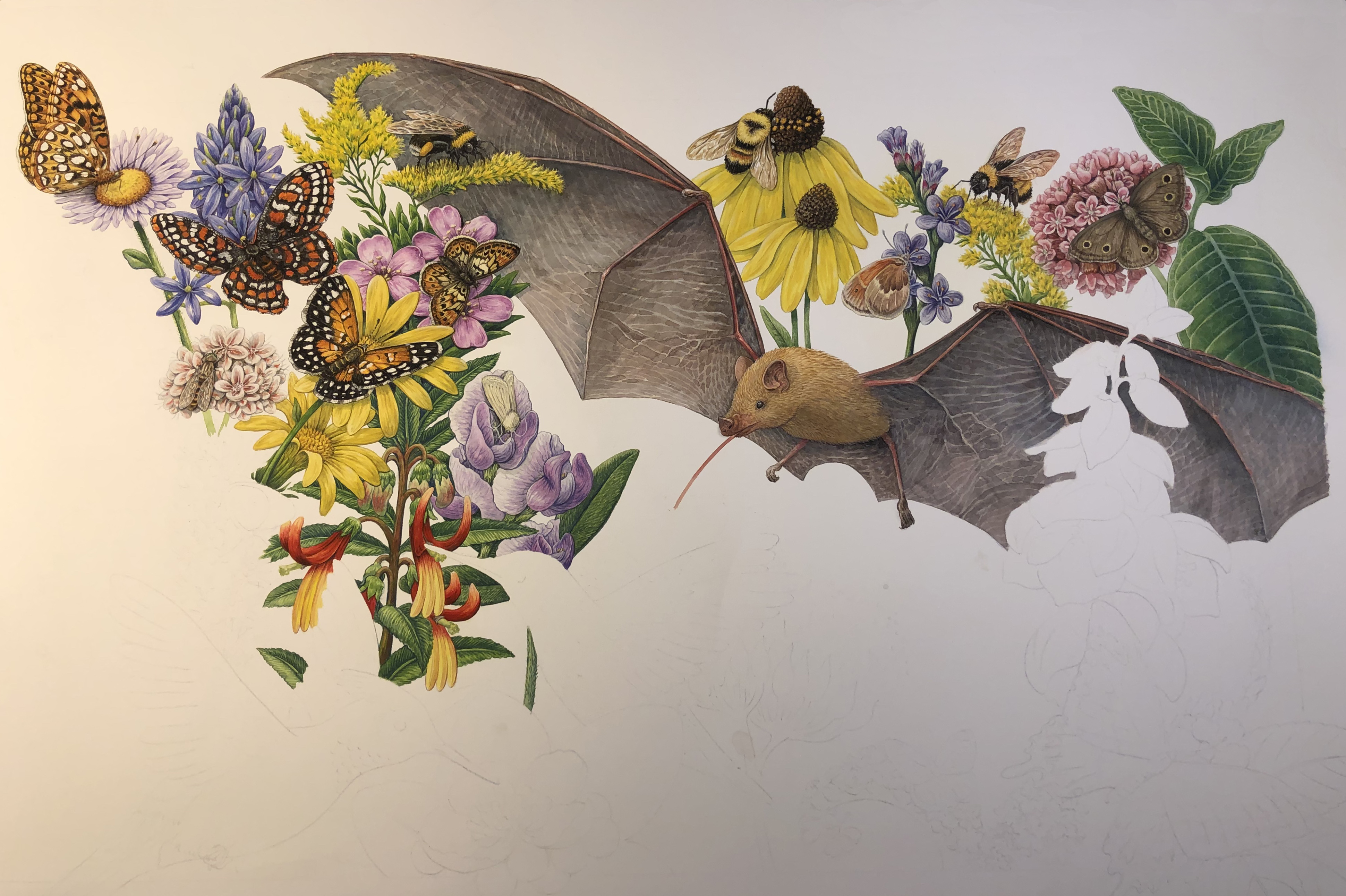
After my pencil sketch was approved, I transferred it to my boards. I started with a light wash of color, working on a small group of species at a time. I built up the colors, adding darker areas and keeping light areas light. The details came next followed by any adjustments. I worked my way across the top portion of the poster in this way, then the middle, and finally the bottom.
After each species was painted I scanned the artwork on my large flatbed scanner. I then opened each portion in Photoshop and pieces it all together. I cleaned up any mistakes, added the rules, then the type.
For the title I chose a distressed looking font. I was thinking about how a butterfly’s wings look rough and choppy along the edges after the many challenges they face in their short lives. This idea relates to the challenges all endangered pollinators face. I also wanted to show the species cut off at each side, suggesting that there are more than those shown.
After many hours of research and painting it felt great to send the digital file ready to print.
Learn more about Carol by visiting her website.
Other Artists: